A Multi-proxy Provenance Study of Late Carboniferous to Middle Jurassic Sandstones in the Eastern Sverdrup Basin and Its Bearing on Arctic Palaeogeographic Reconstructions
Abstract
1. Introduction
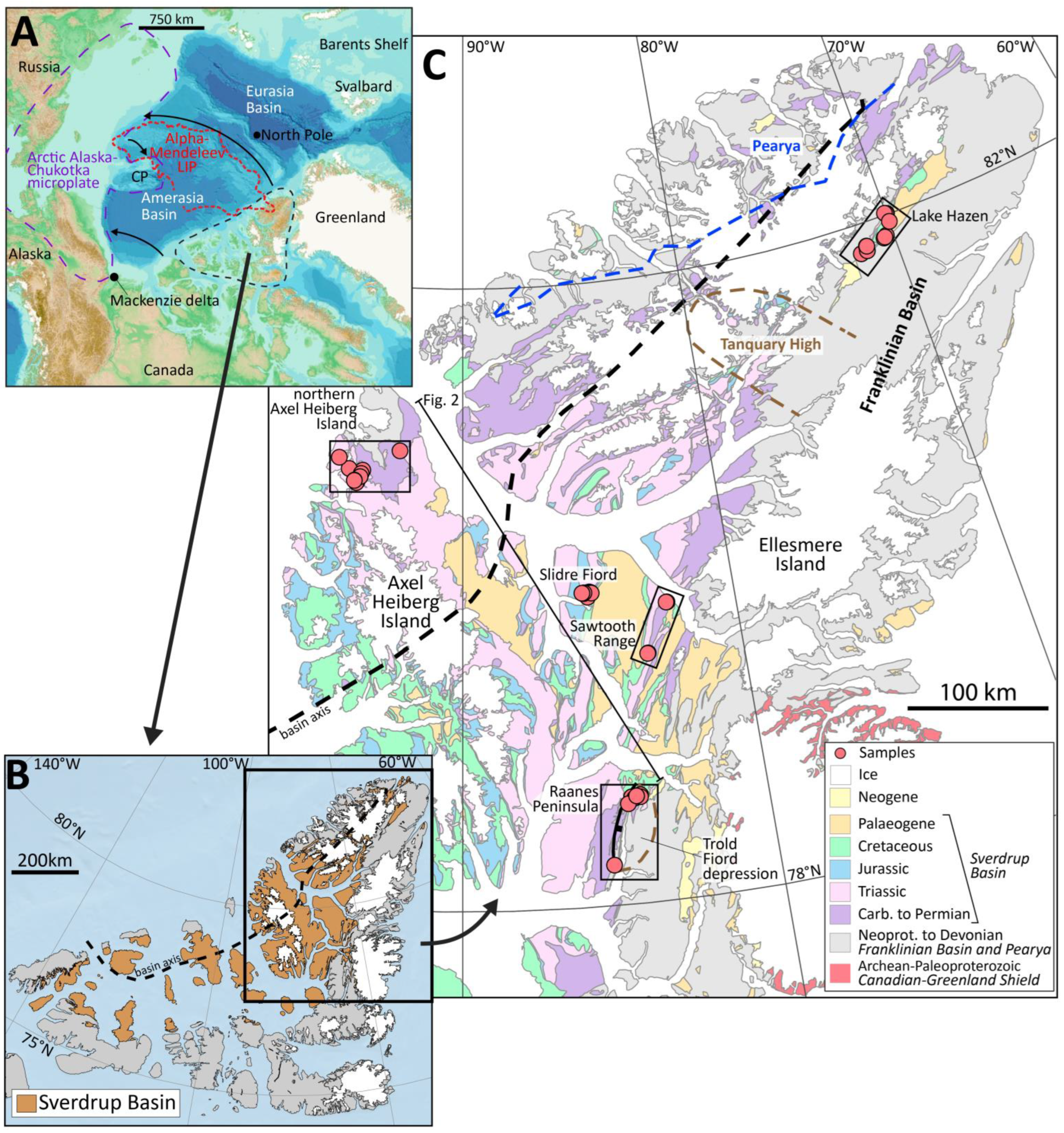
2. Geological Background
Sverdrup Basin
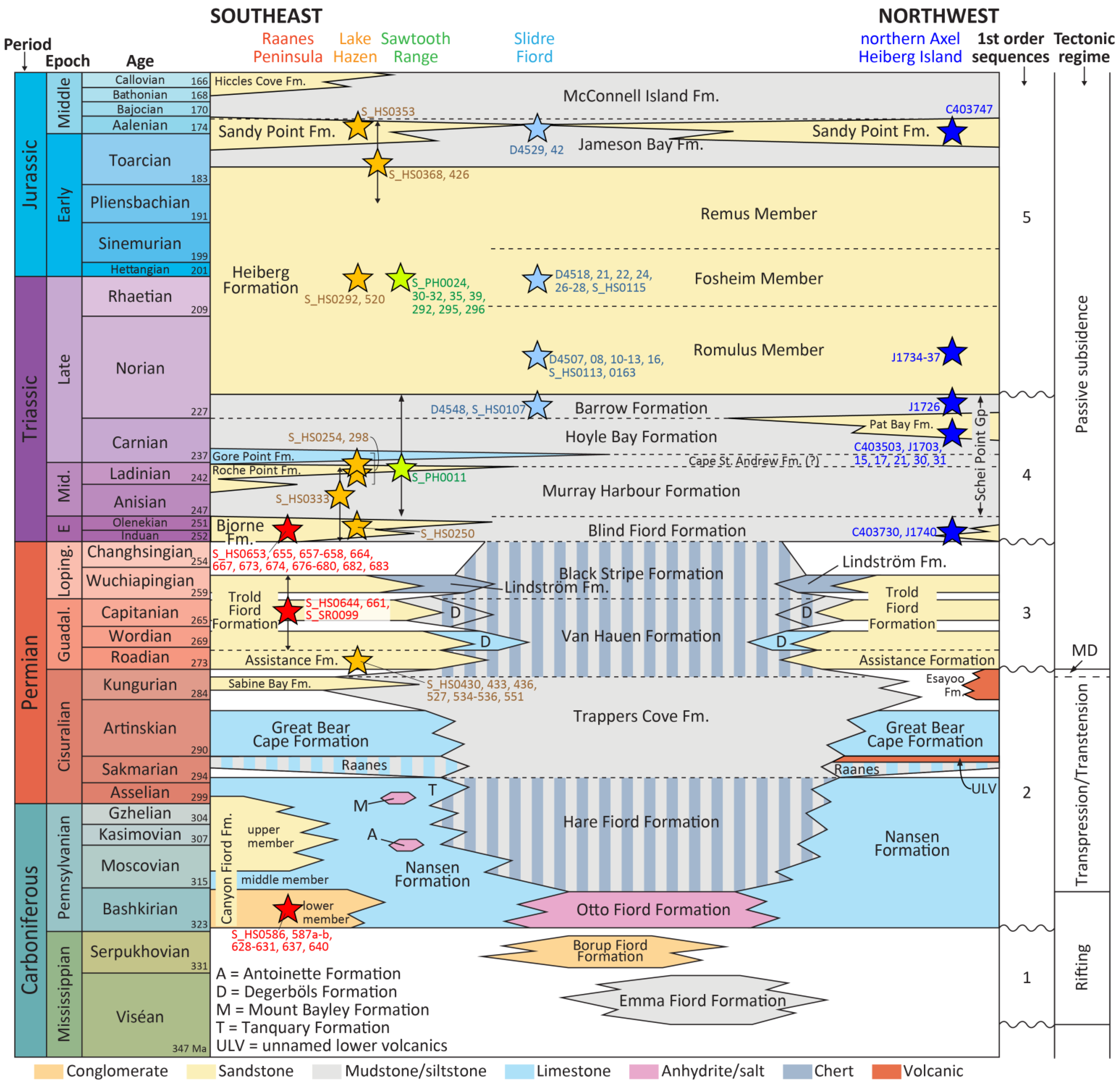
3. Materials and Methods
3.1. Samples
3.2. Methods
3.2.1. Petrography
3.2.2. Conventional Heavy Mineral Analysis
3.2.3. Mineral Chemistry
3.2.4. Detrital Zircon U–Pb Geochronology
3.2.5. Detrital Zircon Hafnium Isotope Analysis
4. Results
4.1. Optical Petrographic Analysis
4.2. Conventional Heavy Mineral Analyses
4.3. Apatite Chemistry
4.4. Garnet Chemistry
4.5. Rutile Chemistry
4.6. Detrital Zircon U–Pb Geochronology
4.7. Detrital Zircon Hafnium Isotopes
5. Discussion
5.1. Carboniferous to Earliest Late Triassic Sediment Supply on the Southern Basin Margin
5.2. Middle Permian to Early Triassic Sediment Supply on the Northern Basin Margin

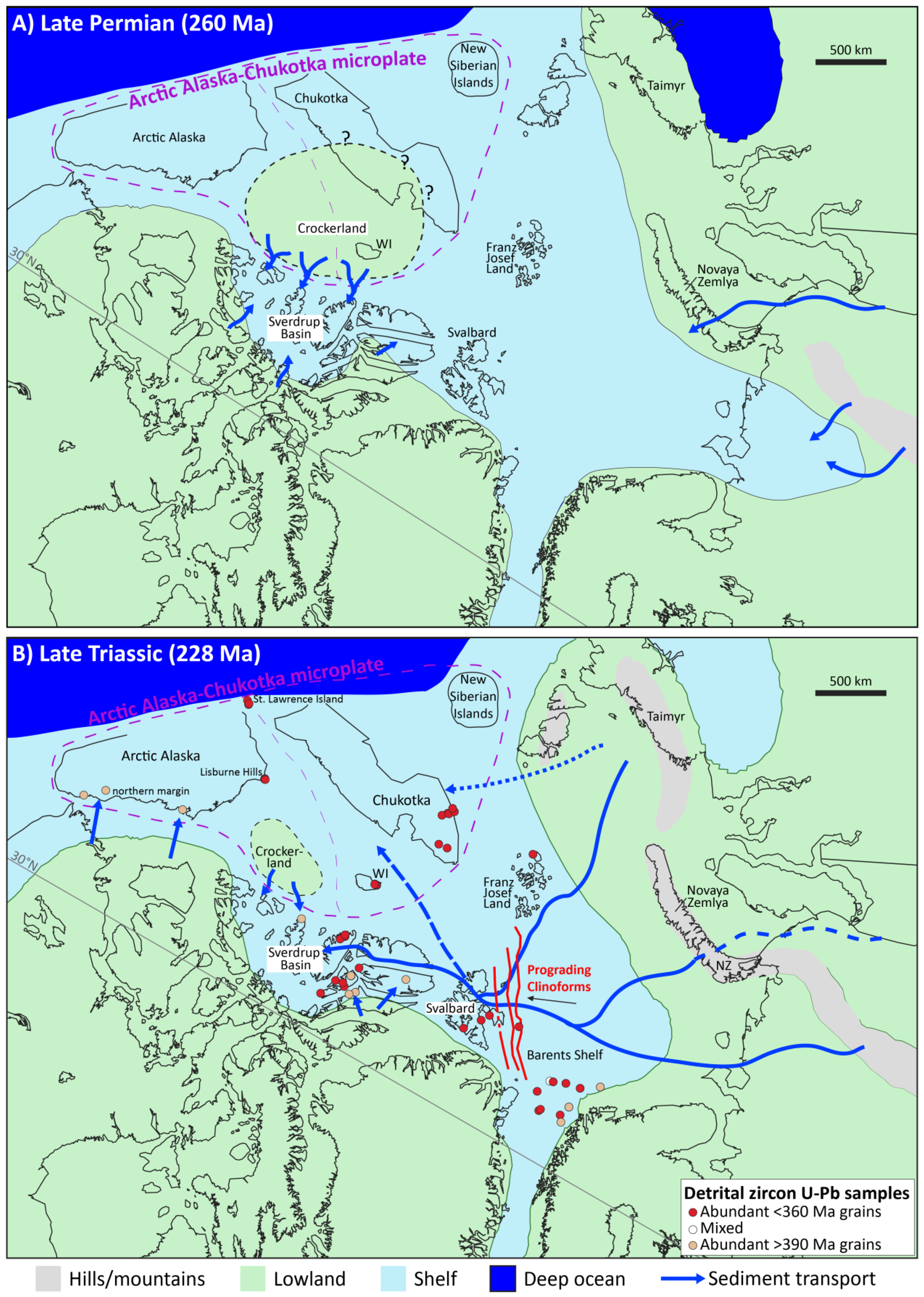
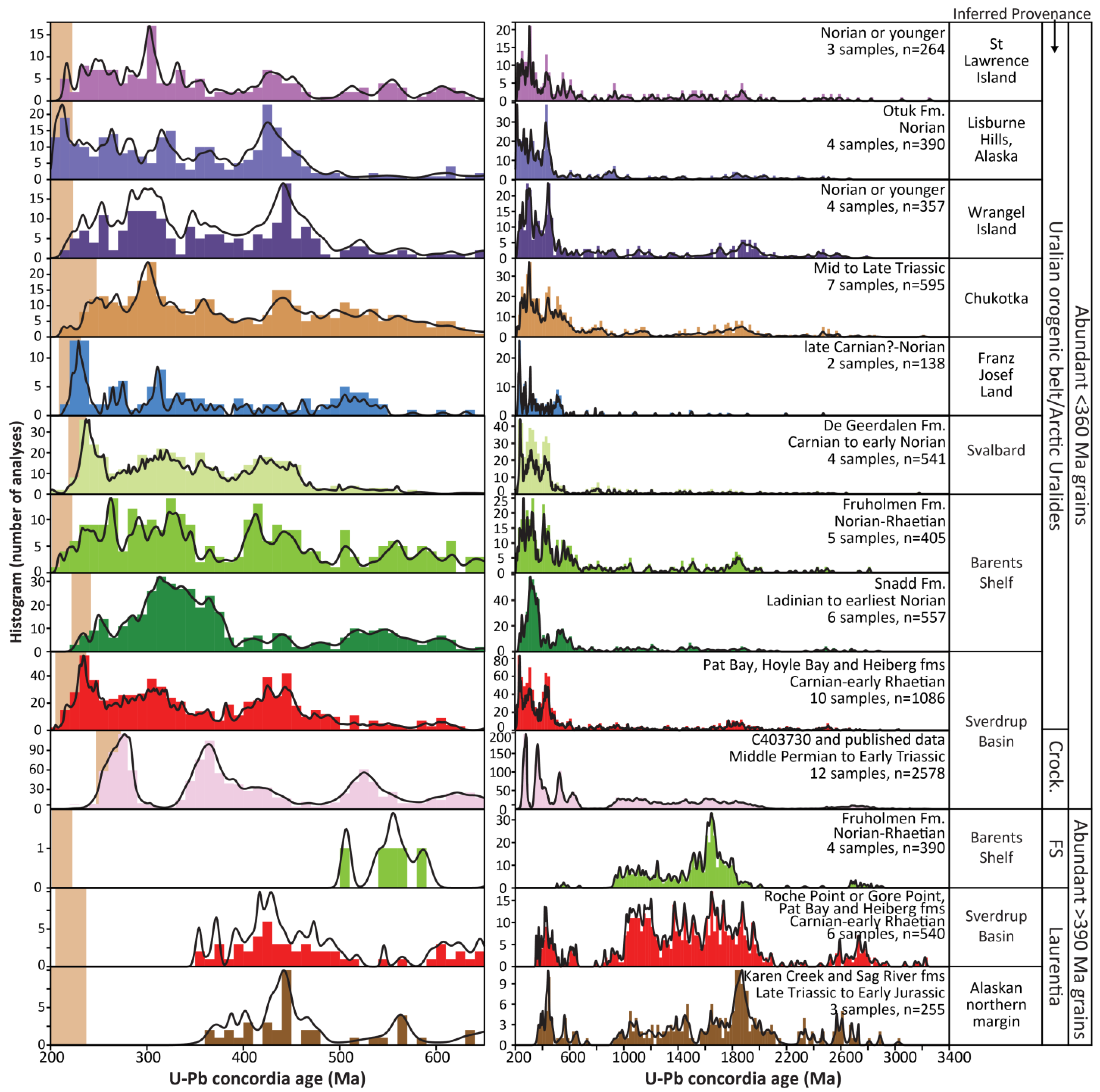
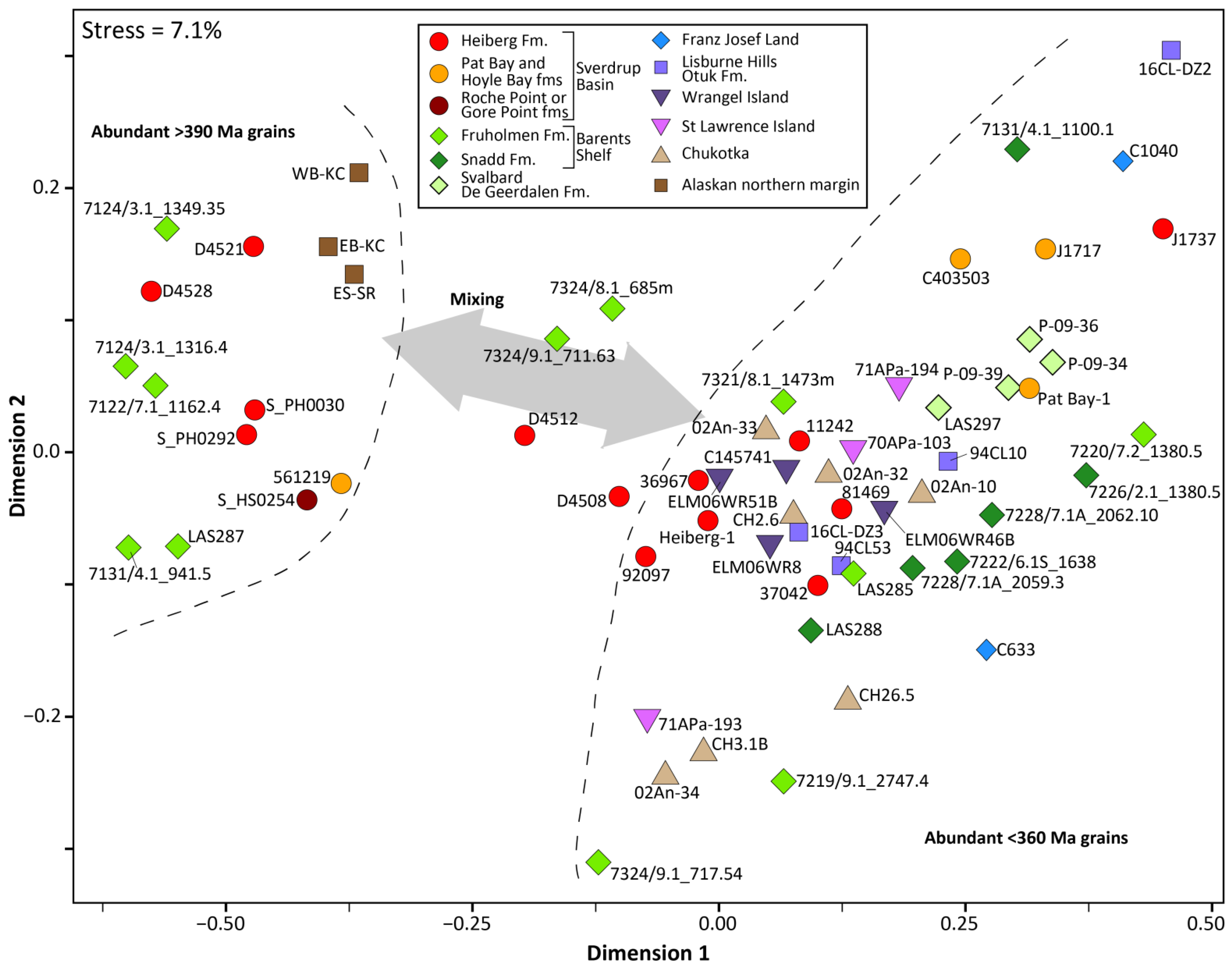
5.3. Late Triassic Sediment Supply on the Northern Basin Margin
5.4. Latest Triassic to Middle Jurassic Sediment Supply on Both Basin Margins
5.5. Triassic to Jurassic Regional Palaeogeographic Implications
6. Conclusions
Supplementary Materials
Author Contributions
Funding
Data Availability Statement
Acknowledgments
Conflicts of Interest
References
- Coakley, B.; Brumley, K.; Lebedeva-Ivanova, N.; Mosher, D. Exploring the geology of the central Arctic Ocean; understanding the basin features in place and time. J. Geol. Soc. 2016, 173, 967–987. [Google Scholar] [CrossRef]
- Døssing, A.; Jackson, H.R.; Matzka, J.; Einarsson, I.; Rasmussen, T.M.; Olesen, A.V.; Brozena, J.M. On the origin of the Amerasia Basin and the High Arctic Large Igneous Province—Results of new aeromagnetic data. Earth Planet. Sci. Lett. 2013, 363, 219–230. [Google Scholar] [CrossRef]
- Grantz, A.; Hart, P.E.; Childers, V.A. Geology and tectonic development of the Amerasia and Canada Basins, Arctic Ocean. Geol. Soc. Lond. Mem. 2011, 35, 771–799. [Google Scholar] [CrossRef]
- Lawver, L.A.; Scotese, C.R. A review of tectonic models for the evolution of the Canada Basin. Geol. N. Am. 1990, 50, 593–618. [Google Scholar]
- Nikishin, A.M.; Petrov, E.I.; Cloetingh, S.; Freiman, S.I.; Malyshev, N.A.; Morozov, A.F.; Posamentier, H.W.; Verzhbitsky, V.E.; Zhukov, N.N.; Startseva, K. Arctic Ocean Mega Project: Paper 3—Mesozoic to Cenozoic geological evolution. Earth Sci. Rev. 2021, 217, 103034. [Google Scholar] [CrossRef]
- Pease, V.; Drachev, S.; Stephenson, R.; Zhang, X. Arctic lithosphere—A review. Tectonophysics 2014, 628, 1–25. [Google Scholar] [CrossRef]
- Miller, E.L.; Meisling, K.E.; Akinin, V.V.; Brumley, K.; Coakley, B.J.; Gottlieb, E.S.; Hoiland, C.W.; O’Brien, T.M.; Soboleva, A.; Toro, J. Circum-Arctic Lithosphere Evolution (CALE) Transect C: Displacement of the Arctic Alaska–Chukotka microplate towards the Pacific during opening of the Amerasia Basin of the Arctic. Geol. Soc. Spec. Publ. 2018, 460, 57–120. [Google Scholar] [CrossRef]
- Miller, E.L.; Gehrels, G.E.; Pease, V.; Sokolov, S. Stratigraphy and U-Pb detrital zircon geochronology of Wrangel Island, Russia: Implications for Arctic paleogeography. AAPG Bull. 2010, 94, 665–692. [Google Scholar] [CrossRef]
- Miller, E.L.; Soloviev, A.V.; Prokopiev, A.V.; Toro, J.; Harris, D.; Kuzmichev, A.B.; Gehrels, G.E. Triassic river systems and the paleo-Pacific margin of northwestern Pangea. Gondwana Res. 2013, 23, 1631–1645. [Google Scholar] [CrossRef]
- Miller, E.L.; Toro, J.; Gehrels, G.; Amato, J.M.; Prokopiev, A.; Tuchkova, M.I.; Akinin, V.V.; Dumitru, T.A.; Moore, T.E.; Cecile, M.P. New insights into Arctic paleogeography and tectonics from U-Pb detrital zircon geochronology. Tectonics 2006, 25, TC3013. [Google Scholar] [CrossRef]
- Gottlieb, E.S.; Meisling, K.E.; Miller, E.L.; Mull, C.G.G. Closing the Canada Basin: Detrital zircon geochronology relationships between the North Slope of Arctic Alaska and the Franklinian mobile belt of Arctic Canada. Geosphere 2014, 10, 1366–1384. [Google Scholar] [CrossRef]
- Pease, V.L.; Kuzmichev, A.B.; Danukalova, M.K. The New Siberian Islands and evidence for the continuation of the Uralides, Arctic Russia. J. Geol. Soc. 2015, 172, 1–4. [Google Scholar] [CrossRef]
- Ershova, V.B.; Khudoley, A.K.; Prokopiev, A.V.; Tuchkova, M.I.; Fedorov, P.V.; Kazakova, G.G.; Shishlov, S.B.; O’Sullivan, P. Trans-Siberian Permian rivers: A key to understanding Arctic sedimentary provenance. Tectonophysics 2016, 691, 220–233. [Google Scholar] [CrossRef]
- Ershova, V.B.; Lorenz, H.; Prokopiev, A.V.; Sobolev, N.N.; Khudoley, A.K.; Petrov, E.O.; Estrada, S.; Sergeev, S.; Larionov, A.; Thomsen, T.B. The De Long Islands: A missing link in unraveling the Paleozoic paleogeography of the Arctic. Gondwana Res. 2016, 35, 305–322. [Google Scholar] [CrossRef]
- Alonso-Torres, D.; Beauchamp, B.; Guest, B.; Hadlari, T.; Matthews, W. Late Paleozoic to Triassic arc magmatism north of the Sverdrup Basin in the Canadian Arctic: Evidence from detrital zircon U-Pb geochronology. Lithosphere 2018, 10, 426–445. [Google Scholar] [CrossRef]
- Balkwill, H.R. Evolution of Sverdrup Basin, Arctic Canada. AAPG Bull. 1978, 62, 1004–1028. [Google Scholar]
- Embry, A.F. Crockerland—The Source Area for the Triassic to Middle Jurassic Strata of Northern Axel Heiberg Island, Canadian Arctic Islands. Bull. Can. Pet. Geol. 2009, 57, 129–140. [Google Scholar] [CrossRef]
- Embry, A.F.; Beauchamp, B. Sverdrup Basin. In The Sedimentary Basins of the United States and Canada, 2nd ed.; Miall, A.D., Ed.; Elsevier: Amsterdam, The Netherlands, 2019; pp. 559–592. [Google Scholar]
- Embry, A.F.; Beauchamp, B. Sverdrup Basin. In The Sedimentary Basins of the United States and Canada, 1st ed.; Miall, A.D., Ed.; Elsevier: Amsterdam, The Netherlands, 2008; pp. 451–471. [Google Scholar]
- Embry, A.F. Mesozoic History of the Arctic Islands. In Geology of the Innuitian Orogen and Arctic Platform of Canada and Greenland. Geology of Canada no. 3; Trettin, H.P., Ed.; Geological Survey of Canada: Ottawa, ON, Canada, 1991; pp. 371–433. [Google Scholar]
- Smyth, H.R.; Morton, A.; Scott, R.A.; Omma, J.E.; Kelly, S.R.; Rippington, S.; Braham, B.; Gregory, U.J.; Jolley, D. Evolution of the Sverdrup Basin: New insights from field studies, integrated biostratigraphy & sediment provenance analyses. In Proceedings of the GeoCanada 2010—Working with the Earth, Calgary, AB, Canada, 10–14 May 2010; pp. 1–4. [Google Scholar]
- Patchett, P.J.; Embry, A.F.; Ross, G.M.; Beauchamp, B.; Harrison, J.C.; Mayr, U.; Isachsen, C.E.; Rosenberg, E.J.; Spence, G.O. Sedimentary Cover of the Canadian Shield through Mesozoic Time Reflected by Nd Isotopic and Geochemical Results for the Sverdrup Basin, Arctic Canada. J. Geol. 2004, 112, 39–57. [Google Scholar] [CrossRef]
- Embry, A.F. Crockerland—The northwest source area for the Sverdrup Basin, Canadian Arctic Islands. In Arctic Geology and Petroleum Potential; Vorren, T.O., Bergsager, E., Dahl-Stamnes, Ø.A., Holter, E., Johansen, B., Lie, E., Lund, T.B., Eds.; Elsevier: Amsterdam, The Netherlands, 1993; Volume 2, pp. 205–216. [Google Scholar]
- Laverov, N.P.; Lobkovsky, L.I.; Kononov, M.V.; Dobretsov, N.L.; Vernikovsky, V.A.; Sokolov, S.D.; Shipilov, E.V. A geodynamic model of the evolution of the Arctic basin and adjacent territories in the Mesozoic and Cenozoic and the outer limit of the Russian Continental Shelf. Geotectonics 2013, 47, 1–30. [Google Scholar] [CrossRef]
- Zonenshain, L.P.; Natapov, L.M. Tectonic History of the Arctic Region from the Ordovician Through the Cretaceous. In The Arctic Seas: Climatology, Oceanography, Geology, and Biology; Herman, Y., Ed.; Springer: Boston, MA, USA, 1989; pp. 829–862. [Google Scholar]
- Embry, A.F. Geological and geophysical evidence in support of the hypothesis of anticlockwise rotation of northern Alaska. Mar. Geol. 1990, 93, 317–329. [Google Scholar] [CrossRef]
- Embry, A.F.; Dixon, J. The age of the Amerasia Basin. In Proceedings of the 1992 International Conference on Arctic Margins, Anchorage, AK, USA, 2–4 September 1992; pp. 289–295. [Google Scholar]
- Grantz, A.; May, S.D.; Hart, P.E. Geology of the Arctic Continental Margin of Alaska. In The Arctic Ocean Region; Grantz, A., Johnson, L., Sweeney, J.F., Eds.; Geological Society of America: Boulder, CO, USA, 1990; Volume L, pp. 257–288. [Google Scholar]
- Embry, A.F.; Anfinson, O.A. A History of Crockerland—The Little Arctic Terrane that Could. In Proceedings of the GeoConvention 2013: Integration, Calgary, AB, Canada, 6–12 May 2013; pp. 1–4. [Google Scholar]
- Hadlari, T.; Dewing, K.; Matthews, W.A.; Alonso-Torres, D.; Midwinter, D. Early Triassic development of a foreland basin in the Canadian high Arctic: Implications for a Pangean Rim of Fire. Tectonophysics 2018, 736, 75–84. [Google Scholar] [CrossRef]
- Galloway, B.J.; Dewing, K.; Beauchamp, B.; Matthews, W. Upper Paleozoic stratigraphy and detrital zircon geochronology along the northwest margin of the Sverdrup Basin, Arctic Canada: Insight into the paleogeographic and tectonic evolution of Crockerland. Can. J. Earth Sci. 2021, 58, 164–187. [Google Scholar] [CrossRef]
- Anfinson, O.A.; Embry, A.F.; Stockli, D.F. Geochronologic Constraints on the Permian–Triassic Northern Source Region of the Sverdrup Basin, Canadian Arctic Islands. Tectonophysics 2016, 691, 206–219. [Google Scholar] [CrossRef]
- Midwinter, D.; Hadlari, T.; Davis, W.J.; Dewing, K.; Arnott, R.W.C. Dual provenance signatures of the Triassic northern Laurentian margin from detrital-zircon U-Pb and Hf-isotope analysis of Triassic–Jurassic strata in the Sverdrup Basin. Lithosphere 2016, 8, 668–683. [Google Scholar] [CrossRef]
- Omma, J.E.; Pease, V.; Scott, R.A. U–Pb SIMS zircon geochronology of Triassic and Jurassic sandstones on northwestern Axel Heiberg Island, northern Sverdrup Basin, Arctic Canada. Geol. Soc. Lond. Mem. 2011, 35, 559–566. [Google Scholar] [CrossRef]
- Pease, V. Eurasian orogens and Arctic tectonics: An overview. Geol. Soc. Lond. Mem. 2011, 35, 311–324. [Google Scholar] [CrossRef]
- Hadlari, T.; Midwinter, D.; Galloway, J.M.; Dewing, K.; Durbano, A.M. Mesozoic rift to post-rift tectonostratigraphy of the Sverdrup Basin, Canadian Arctic. Mar. Pet. Geol. 2016, 76, 148–158. [Google Scholar] [CrossRef]
- Jakobsson, M.; Mayer, L.A.; Bringensparr, C.; Castro, C.F.; Mohammad, R.; Johnson, P.; Ketter, T.; Accettella, D.; Amblas, D.; An, L.; et al. The International Bathymetric Chart of the Arctic Ocean Version 4.0. Sci. Data 2020, 7, 176. [Google Scholar] [CrossRef]
- Harrison, J.; St-Onge, M.; Petrov, O.; Strelnikov, S.; Lopatin, B.; Wilson, F.; Tella, S.; Paul, D.; Lynds, T.; Shokalsky, S. Geological Map of the Arctic. Map 2159A; Geological Survey of Canada: Ottawa, ON, Canada, 2011.
- St-Onge, M.R.; Van Gool, J.A.M.; Garde, A.A.; Scott, D.J. Correlation of Archaean and Palaeoproterozoic units between northeastern Canada and western Greenland: Constraining the pre-collisional upper plate accretionary history of the Trans-Hudson orogen. Geol. Soc. Spec. Publ. 2009, 318, 193–235. [Google Scholar] [CrossRef]
- Frisch, T. Reconnaissance Geology of the Precambrian Shield of Ellesmere, Devon and Coburg Islands, Arctic Archipelago: A Preliminary Account; Geological Survey of Canada Paper; Geological Survey of Canada: Ottawa, ON, Canada, 1983; Volume 82-10, pp. 1–11.
- Frisch, T.; Hunt, P.A. U-Pb zircon and motzcizite ages from the Precambrian Shield of Ellesmere and Devon islands, Artic Archipelago. In U-Pb Zircon and Motzcizite Ages from the Precambrian Shield of Ellesmere and Devon islands, Artic Archipelago. Radiogenic Age and Isotopic Studies: Report 2; Geological Survey of Canada Paper; Geological Survey of Canada: Ottawa, ON, Canada, 1988; Volume 88-2, pp. 117–125. [Google Scholar]
- Anfinson, O.A.; Leier, A.L.; Embry, A.F.; Dewing, K. Detrital zircon geochronology and provenance of the Neoproterozoic to Late Devonian Franklinian Basin, Canadian Arctic Islands. Geol. Soc. Am. Bull. 2012, 124, 415–430. [Google Scholar] [CrossRef]
- Anfinson, O.A.; Leier, A.L.; Gaschnig, R.; Embry, A.F.; Dewing, K.; Colpron, M. U–Pb and Hf isotopic data from Franklinian Basin strata: Insights into the nature of Crockerland and the timing of accretion, Canadian Arctic Islands. Can. J. Earth Sci. 2012, 49, 1316–1328. [Google Scholar] [CrossRef]
- Thorsteinsson, R.; Tozer, E. Summary Account of Structural History of the Canadian Arctic Archipelago since Precambrian Time; Geological Survey of Canada Paper; Geological Survey of Canada: Ottawa, ON, Canada, 1960; Volume 60–67, pp. 1–25.
- Thorsteinsson, R.; Tozer, E. Geology of the Arctic archipelago. In Geology and Economic Minerals of Canada; Douglas, R.J.W., Ed.; Department of Energy, Mines and Resources: Ottawa, ON, Canada, 1970; Volume 1, pp. 547–590. [Google Scholar]
- Trettin, H.P.; Mayr, U.; Long, G.D.F.; Packard, J.J. Cambrian to Early Devonian Basin Development, Sedimentation, and Volcanism, Arctic Islands. Geology of Canada no. 3. In Geology of the Innuitian Orogen and Arctic Platform of Canada and Greenland; Trettin, H.P., Ed.; Geological Survey of Canada: Ottawa, ON, Canada, 1991; pp. 165–238. [Google Scholar]
- Beranek, L.P.; Pease, V.; Scott, R.A.; Thomsen, T.B.; Mahoney, J.B. Detrital zircon geochronology of Ediacaran to Cambrian deep-water strata of the Franklinian basin, northern Ellesmere Island, Nunavut: Implications for regional stratigraphic correlations. Can. J. Earth Sci. 2013, 50, 1007–1018. [Google Scholar] [CrossRef]
- Dewing, K.; Harrison, J.C.; Pratt, B.R.; Mayr, U. A probable late Neoproterozoic age for the Kennedy Channel and Ella Bay formations, northeastern Ellesmere Island and its implications for passive margin history of the Canadian Arctic. Can. J. Earth Sci. 2004, 41, 1013–1025. [Google Scholar] [CrossRef]
- Patchett, P.J.; Roth, M.A.; Canale, B.S.; de Freitas, T.A.; Harrison, J.C.; Embry, A.F.; Ross, G.M. Nd isotopes, geochemistry, and constraints on sources of sediments in the Franklinian mobile belt, Arctic Canada. GSA Bull. 1999, 111, 578–589. [Google Scholar] [CrossRef]
- Malone, S.J.; McClelland, W.C.; Gosen, W.v.; Piepjohn, K. Detrital zircon U-Pb and Lu-Hf analysis of Paleozoic sedimentary rocks from the Pearya terrane and Ellesmerian Fold Belt (northern Ellesmere Island): A comparison with Circum-Arctic datasets and their implications on terrane tectonics. Geol. Soc. Am. Spec. Pap. 2018, 541, 231–254. [Google Scholar]
- Trettin, H.P. Pearya: A composite terrane with Caledonian affinities in northern Ellesmere Island. Can. J. Earth Sci. 1987, 24, 224–245. [Google Scholar] [CrossRef]
- Trettin, H.P. The Proterozoic to Late Silurian Record of Pearya. In Geology of the Innuitian Orogen and Arctic Platform of Canada and Greenland. Geology of Canada no.3; Trettin, H.P., Ed.; Geological Survey of Canada: Ottawa, ON, Canada, 1991; pp. 241–260. [Google Scholar]
- Dewing, K.; Hadlari, T.; Pearson, D.G.; Matthews, W. Early Ordovician to Early Devonian tectonic development of the northern margin of Laurentia, Canadian Arctic Islands. GSA Bull. 2019, 131, 1075–1094. [Google Scholar] [CrossRef]
- Malone, S.J.; McClelland, W.C.; von Gosen, W.; Piepjohn, K. Proterozoic Evolution of the North Atlantic–Arctic Caledonides: Insights from Detrital Zircon Analysis of Metasedimentary Rocks from the Pearya Terrane, Canadian High Arctic. J. Geol. 2014, 122, 623–647. [Google Scholar] [CrossRef]
- Malone, S.J.; McClelland, W.C.; von Gosen, W.; Piepjohn, K. The earliest Neoproterozoic magmatic record of the Pearya terrane, Canadian high Arctic: Implications for Caledonian terrane reconstructions. Precambrian Res. 2017, 292, 323–349. [Google Scholar] [CrossRef]
- Trettin, H.P.; Parrish, R.; Roddick, J. New U-Pb and 40Ar-39Ar age determinations from northern Ellesmere and Axel Heiberg Islands and their tectonic significance. In Radiogenic Age and Isotopic Studies: Report 6; Geological Survey of Canada Paper; Geological Survey of Canada: Ottawa, ON, Canada, 1992; Volume 92-2, pp. 3–30. [Google Scholar]
- Hadlari, T.; Davis, W.J.; Dewing, K. A pericratonic model for the Pearya terrane as an extension of the Franklinian margin of Laurentia, Canadian Arctic. Geol. Soc. Am. Bull. 2014, 126, 182–200. [Google Scholar] [CrossRef]
- Beranek, L.P.; Pease, V.; Hadlari, T.; Dewing, K. Silurian flysch successions of Ellesmere Island, Arctic Canada, and their significance to northern Caledonian palaeogeography and tectonics. J. Geol. Soc. 2015, 172, 201–212. [Google Scholar] [CrossRef]
- Embry, A.F. Middle-Upper Devonian Clastic Wedge of the Arctic Islands. In Geology of the Innuitian Orogen and Arctic Platform of Canada and Greenland. Geology of Canada no. 3; Trettin, H.P., Ed.; Geological Survey of Canada: Ottawa, ON, Canada, 1991; pp. 263–280. [Google Scholar]
- Embry, A.F.; Klovan, J.E. The Middle-Upper Devonian clastic wedge of the Franklinian geosyncline. Bull. Can. Pet. Geol. 1976, 24, 485–639. [Google Scholar]
- Embry, A.F. Middle-Upper Devonian sedimentation in the Canadian Arctic Islands and the Ellesmerian Orogeny. In Devonian of the World: Proceedings of the 2nd International Symposium on the Devonian System—Volume II: Sedimentation; McMillan, N.J., Embry, A.F., Glass, D.J., Eds.; Canadian Society of Petroleum Geologists: Calgary, AB, Canada, 1988; Volume 14, pp. 15–28. [Google Scholar]
- Beauchamp, B. Carboniferous and Permian subsurface stratigraphy, Prince Patrick Island, Northwest Territories, Canadian Arctic. Geol. Surv. Can. Bull. 2001, 565, 1–96. [Google Scholar]
- Davies, G.R.; Nassichuk, W.W. Carboniferous and Permian History of the Sverdrup Basin, Arctic Islands. In Geology of the Innuitian Orogen and Arctic Platform of Canada and Greenland. Geology of Canada no. 3; Trettin, H.P., Ed.; Geological Survey of Canada: Ottawa, ON, Canada, 1991; pp. 345–367. [Google Scholar]
- Trettin, H.P. Early Namurian (or older) alkali basalt in the Borup Fiord Formation, northern Axel Heiberg Island, Arctic Canada. In Current Research, Part D, Interior Plains and Arctic Canada; Geological Survey of Canada Paper; Geological Survey of Canada: Ottawa, ON, Canada, 1988; Volume 88-1D, pp. 21–26. [Google Scholar]
- Nassichuk, W.W.; Davies, G.R. Stratigraphy and Sedimentation of the Otto Fiord Formation-a Major Mississippian Pennsylvanian Evaporite of Subaqueous Origin in the Canadian Arctic Archipelago. Geol. Surv. Can. Bull. 1980, 286, 1–87. [Google Scholar]
- Cameron, B.I.; Muecke, G.K. Permian alkaline basalts associated with formation of the Sverdrup Basin, Canadian Arctic. Can. J. Earth Sci. 1996, 33, 1462–1473. [Google Scholar] [CrossRef]
- Morris, N. Stratigraphy and Geochemistry of Lower Permian volcanics in the Sverdrup Basin, Northwest Ellesmere Island, Nunavut. Master’s Thesis, University of Calgary, Calgary, AB, Canada, 2013. [Google Scholar]
- Lopez-Mir, B.; Schneider, S.; Hülse, P. Fault activity and diapirism in the Mississippian to Late Cretaceous Sverdrup Basin: New insights into the tectonic evolution of the Canadian Arctic. J. Geodyn. 2018, 118, 55–65. [Google Scholar] [CrossRef]
- Embry, A.F. The Wilkie Point Group (Lower-Upper Jurassic), Sverdrup Basin, Arctic Islands. In Current Research, Part B; Geological Survey of Canada Paper; Geological Survey of Canada: Ottawa, ON, Canada, 1984; Volume 84-1B, pp. 299–308. [Google Scholar]
- Cohen, K.M.; Finney, S.C.; Gibbard, P.L.; Fan, J.-X. The ICS international chronostratigraphic chart. Episodes 2013, 36, 199–204. [Google Scholar] [CrossRef]
- Thorsteinsson, R. Carboniferous and Permian stratigraphy of Axel Heiberg Island and western Ellesmere Island, Canadian Arctic Archipelago. Geol. Surv. Can. Bull. 1974, 224, 1–115. [Google Scholar]
- Stephenson, R.; Boerstoel, J.; Embry, A.F.; Ricketts, B.D. Subsidence analysis and tectonic modeling of the Sverdrup Basin. In Proceedings of the 1992 International Conference on Arctic Margins, Anchorage, AK, USA, 2–4 September 1992; pp. 149–154. [Google Scholar]
- Embry, A.F. Petroleum prospectivity of the Triassic–Jurassic succession of Sverdrup Basin, Canadian Arctic Archipelago. Geol. Soc. Lond. Mem. 2011, 35, 545–558. [Google Scholar] [CrossRef]
- Boutelier, J.; Cruden, A.; Brent, T.; Stephenson, R. Timing and mechanisms controlling evaporite diapirism on Ellef Ringnes Island, Canadian Arctic Archipelago. Basin Res. 2011, 23, 478–498. [Google Scholar] [CrossRef]
- Harrison, J.C.; Jackson, M.P.A. Exposed evaporite diapirs and minibasins above a canopy in central Sverdrup Basin, Axel Heiberg Island, Arctic Canada. Basin Res. 2014, 26, 567–596. [Google Scholar] [CrossRef]
- Grasby, S.E.; Beauchamp, B.; Bond, D.P.G.; Wignall, P.; Talavera, C.; Galloway, J.M.; Piepjohn, K.; Reinhardt, L.; Blomeier, D. Progressive environmental deterioration in northwestern Pangea leading to the latest Permian extinction. GSA Bull. 2015, 127, 1331–1347. [Google Scholar] [CrossRef]
- Zuchuat, V.; Sleveland, A.R.N.; Twitchett, R.J.; Svensen, H.H.; Turner, H.; Augland, L.E.; Jones, M.T.; Hammer, Ø.; Hauksson, B.T.; Haflidason, H.; et al. A new high-resolution stratigraphic and palaeoenvironmental record spanning the End-Permian Mass Extinction and its aftermath in central Spitsbergen, Svalbard. Palaeogeogr. Palaeoclimatol. Palaeoecol. 2020, 554, 109732. [Google Scholar] [CrossRef]
- Gilmullina, A.; Klausen, T.G.; Doré, A.G.; Rossi, V.M.; Suslova, A.; Eide, C.H. Linking sediment supply variations and tectonic evolution in deep time, source-to-sink systems—The Triassic Greater Barents Sea Basin. GSA Bull. 2021, 134, 1760–1780. [Google Scholar] [CrossRef]
- Thériault, P. Synrift sedimentation in the Upper Carboniferous Canyon Fiord Formation, SW Ellesmere Island, Canadian Arctic. Master’s Thesis, University of Ottawa, Ottawa, ON, Canada, 1991. [Google Scholar]
- Devaney, J.R. Sedimentological highlights of the lower Triassic Bjorne formation, Ellesmere Island, Arctic Archipelago. In Current Research, Part B; Geological Survey of Canada Paper; Geological Survey of Canada: Ottawa, ON, Canada, 1991; Volume 91-1B, pp. 33–40. [Google Scholar]
- Embry, A.F. Stratigraphic subdivision of the Blind Fiord and Bjorne formations (Lower Triassic), Sverdrup Basin, Arctic Islands. In Current Research, Part B; Geological Survey of Canada Paper; Geological Survey of Canada: Ottawa, ON, Canada, 1986; Volume 86-1B, pp. 329–340. [Google Scholar]
- Midwinter, D.; Hadlari, T.; Dewing, K. Lower Triassic river-dominated deltaic successions from the Sverdrup Basin, Canadian Arctic. Palaeogeogr. Palaeoclimatol. Palaeoecol. 2017, 476, 55–67. [Google Scholar] [CrossRef]
- Embry, A.F. The Schei Point and Blaa Mountain Groups (Middle-Upper Triassic), Sverdrup Basin, Canadian Arctic Archipelago. In Current Research, Part B; Geological Survey of Canada Paper; Geological Survey of Canada: Ottawa, ON, Canada, 1984; Volume 84-1B, pp. 327–336. [Google Scholar]
- Suneby, L.B.; Hills, L.V. Palynological zonation of the Heiberg Formation (Triassic-Jurassic) eastern Sverdrup Basin, Arctic Canada. Bull. Can. Pet. Geol. 1988, 36, 347–361. [Google Scholar]
- Embry, A.F. Stratigraphic subdivision of the Heiberg Formation, eastern and central Sverdrup Basin, Arctic Islands. In Current Research, Part B; Geological Survey of Canada Paper; Geological Survey of Canada: Ottawa, ON, Canada, 1983; Volume 83-1B, pp. 205–213. [Google Scholar]
- Embry, A.F. The Upper Triassic-Lower Jurassic Heiberg deltaic complex of the Sverdrup Basin. In Arctic Geology and Geophysics: Proceedings of the Third International Symposium on Arctic Geology; Embry, A.F., Balkwill, H.R., Eds.; Canadian Society of Petroleum Geologists: Calgary, AB, Canada, 1982; pp. 189–217. [Google Scholar]
- Ingersoll, R.V.; Bullard, T.F.; Ford, R.L.; Grimm, J.P.; Pickle, J.D.; Sares, S.W. The effect of grain size on detrital modes: A test of the Gazzi-Dickinson point-counting method. J. Sediment. Res. 1984, 54, 103–116. [Google Scholar]
- Folk, R.L. Petrology of Sedimentary Rocks; Hemphill Publishing Company: Austin, TX, USA, 1980. [Google Scholar]
- Pettijohn, F.J.; Potter, P.E.; Siever, R. Sand and Sandstone; Springer: New York, NY, USA, 1987. [Google Scholar]
- Galehouse, J.S. Point counting. In Procedures in Sedimentary Petrology; Carver, R.E., Ed.; Wiley Interscience: New York, NY, USA, 1971; pp. 385–407. [Google Scholar]
- Morton, A.C.; Hallsworth, C. Identifying provenance-specific features of detrital heavy mineral assemblages in sandstones. Sediment. Geol. 1994, 90, 241–256. [Google Scholar] [CrossRef]
- O’Sullivan, G.; Chew, D.; Kenny, G.; Henrichs, I.; Mulligan, D. The trace element composition of apatite and its application to detrital provenance studies. Earth Sci. Rev. 2020, 201, 103044. [Google Scholar] [CrossRef]
- Meinhold, G.; Anders, B.; Kostopoulos, D.; Reischmann, T. Rutile chemistry and thermometry as provenance indicator: An example from Chios Island, Greece. Sediment. Geol. 2008, 203, 98–111. [Google Scholar] [CrossRef]
- Watson, E.B.; Wark, D.A.; Thomas, J.B. Crystallization thermometers for zircon and rutile. Contrib. Mineral. Petrol. 2006, 151, 413–433. [Google Scholar] [CrossRef]
- Schönig, J.; von Eynatten, H.; Tolosana-Delgado, R.; Meinhold, G. Garnet major-element composition as an indicator of host-rock type: A machine learning approach using the random forest classifier. Contrib. Mineral. Petrol. 2021, 176, 98. [Google Scholar] [CrossRef]
- Ludwig, K.R. On the Treatment of Concordant Uranium-Lead Ages. Geochim. Cosmochim. Acta 1998, 62, 665–676. [Google Scholar] [CrossRef]
- Ludwig, K. User’s Manual for Isoplot 3.75: A Geochronological Toolkit for Microsoft Excel; Berkeley Geochronology Center: Berkeley, CA, USA, 2012; Number 5; p. 75. [Google Scholar]
- Andersen, T.; Kristoffersen, M.; Elburg, M.A. Visualizing, interpreting and comparing detrital zircon age and Hf isotope data in basin analysis—A graphical approach. Basin Res. 2017, 30, 132–147. [Google Scholar] [CrossRef]
- Thomas, R.J.; Spencer, C.; Bushi, A.M.; Baglow, N.; Boniface, N.; de Kock, G.; Horstwood, M.S.A.; Hollick, L.; Jacobs, J.; Kajara, S.; et al. Geochronology of the central Tanzania Craton and its southern and eastern orogenic margins. Precambrian Res. 2016, 277, 47–67. [Google Scholar] [CrossRef]
- Söderlund, U.; Patchett, P.J.; Vervoort, J.D.; Isachsen, C.E. The 176Lu decay constant determined by Lu–Hf and U–Pb isotope systematics of Precambrian mafic intrusions. Earth Planet. Sci. Lett. 2004, 219, 311–324. [Google Scholar] [CrossRef]
- Bouvier, A.; Vervoort, J.D.; Patchett, P.J. The Lu–Hf and Sm–Nd isotopic composition of CHUR: Constraints from unequilibrated chondrites and implications for the bulk composition of terrestrial planets. Earth Planet. Sci. Lett. 2008, 273, 48–57. [Google Scholar] [CrossRef]
- Hamilton, N.E.; Ferry, M. ggtern: Ternary Diagrams Using ggplot2. J. Stat. Softw. Code Snippets 2018, 87, 1–17. [Google Scholar] [CrossRef]
- Vervoort, J.D.; Patchett, P.J.; Blichert-Toft, J.; Albarède, F. Relationships between Lu–Hf and Sm–Nd isotopic systems in the global sedimentary system. Earth Planet. Sci. Lett. 1999, 168, 79–99. [Google Scholar] [CrossRef]
- Røhr, T.S.; Davis, W.; Andersen, T.; Dypvik, H.; Embry, A.F. Detrital zircon characteristics of the Lower Cretaceous Isachsen Formation, Sverdrup Basin: Source constraints from age and Hf isotope data. Can. J. Earth Sci. 2010, 47, 255–271. [Google Scholar] [CrossRef]
- Gottlieb, E.S.; Pease, V.; Miller, E.L.; Akinin, V.V. Neoproterozoic basement history of Wrangel Island and Arctic Chukotka: Integrated insights from zircon U–Pb, O and Hf isotopic studies. Geol. Soc. Spec. Publ. 2018, 460, 183–206. [Google Scholar] [CrossRef]
- Akinin, V.V.; Gottlieb, E.S.; Miller, E.L.; Polzunenkov, G.O.; Stolbov, N.M.; Sobolev, N.N. Age and composition of basement beneath the De Long archipelago, Arctic Russia, based on zircon U–Pb geochronology and O–Hf isotopic systematics from crustal xenoliths in basalts of Zhokhov Island. Arktos 2015, 1, 9. [Google Scholar] [CrossRef]
- Sircombe, K.N. Mountains in the shadows of time: Three-dimensional density distribution mapping of U-Pb isotopic data as a visualization aid for geochronological information in concordia diagrams. Geochem. Geophys. Geosyst. 2006, 7, Q07013. [Google Scholar] [CrossRef]
- Griffin, W.L.; Wang, X.; Jackson, S.E.; Pearson, N.J.; O’Reilly, S.Y.; Xu, X.; Zhou, X. Zircon chemistry and magma mixing, SE China: In-situ analysis of Hf isotopes, Tonglu and Pingtan igneous complexes. Lithos 2002, 61, 237–269. [Google Scholar] [CrossRef]
- Cai, K.; Sun, M.; Xiao, W.; Buslov, M.M.; Yuan, C.; Zhao, G.; Long, X. Zircon U-Pb geochronology and Hf isotopic composition of granitiods in Russian Altai Mountain, Central Asian Orogenic Belt. Am. J. Sci. 2014, 314, 580. [Google Scholar] [CrossRef]
- Cao, R.; Bagas, L.; Chen, B.; Wang, Z.; Gao, Y. Geochronology and petrogenesis of the composite Zuluhong Granite, North Xinjiang Province of China: Implications for the crust-mantle interaction and continental crustal growth in Western Tianshan Orogen. Lithos 2021, 380, 105837. [Google Scholar] [CrossRef]
- Chen, B.; Jahn, B.M.; Tian, W. Evolution of the Solonker suture zone: Constraints from zircon U–Pb ages, Hf isotopic ratios and whole-rock Nd–Sr isotope compositions of subduction- and collision-related magmas and forearc sediments. J. Asian Earth Sci. 2009, 34, 245–257. [Google Scholar] [CrossRef]
- He, Z.-Y.; Klemd, R.; Yan, L.-L.; Zhang, Z.-M. The origin and crustal evolution of microcontinents in the Beishan orogen of the southern Central Asian Orogenic Belt. Earth Sci. Rev. 2018, 185, 1–14. [Google Scholar] [CrossRef]
- Li, G.; Cao, M.; Qin, K.; Hollings, P.; Evans, N.J.; Seitmuratova, E.Y. Petrogenesis of ore-forming and pre/post-ore granitoids from the Kounrad, Borly and Sayak porphyry/skarn Cu deposits, Central Kazakhstan. Gondwana Res. 2016, 37, 408–425. [Google Scholar] [CrossRef]
- Li, S.; Wilde, S.A.; Wang, T.; Xiao, W.; Guo, Q. Latest Early Permian granitic magmatism in southern Inner Mongolia, China: Implications for the tectonic evolution of the southeastern Central Asian Orogenic Belt. Gondwana Res. 2016, 29, 168–180. [Google Scholar] [CrossRef]
- Liu, W.; Pan, X.-F.; Liu, D.-Y.; Chen, Z.-Y. Three-step continental-crust growth from subduction accretion and underplating, through intermediary differentiation, to granitoid production. Int. J. Earth Sci. 2009, 98, 1413–1439. [Google Scholar] [CrossRef]
- Li, S.; Chung, S.-L.; Wilde, S.A.; Wang, T.; Xiao, W.-J.; Guo, Q.-Q. Linking magmatism with collision in an accretionary orogen. Sci. Rep. 2016, 6, 25751. [Google Scholar] [CrossRef] [PubMed]
- Li, S.; Wang, T.; Wilde, S.A.; Tong, Y. Evolution, source and tectonic significance of Early Mesozoic granitoid magmatism in the Central Asian Orogenic Belt (central segment). Earth Sci. Rev. 2013, 126, 206–234. [Google Scholar] [CrossRef]
- Li, S.; Wang, T.; Wilde, S.A.; Tong, Y.; Hong, D.; Guo, Q. Geochronology, petrogenesis and tectonic implications of Triassic granitoids from Beishan, NW China. Lithos 2012, 134, 123–145. [Google Scholar] [CrossRef]
- Muhtar, M.N.; Wu, C.-Z.; Santosh, M.; Lei, R.-X.; Feng, Y.; Yang, T.; Ye, H.; Gu, L.-X. Peraluminous granitoid magmatism from isotopically depleted sources: The case of Jing’erquanbei pluton in Eastern Tianshan, Northwest China. Geol. J. 2020, 55, 117–132. [Google Scholar] [CrossRef]
- Shen, P.; Pan, H.; Cao, C.; Zhong, S.; Li, C. The formation of the Suyunhe large porphyry Mo deposit in the West Junggar terrain, NW China: Zircon U–Pb age, geochemistry and Sr–Nd–Hf isotopic results. Ore Geol. Rev. 2017, 81, 808–828. [Google Scholar] [CrossRef]
- Shen, P.; Pan, H.; Hattori, K.; Cooke, D.R.; Seitmuratova, E. Large Paleozoic and Mesozoic porphyry deposits in the Central Asian Orogenic Belt: Geodynamic settings, magmatic sources, and genetic models. Gondwana Res. 2018, 58, 161–194. [Google Scholar] [CrossRef]
- Shen, P.; Pan, H.; Seitmuratova, E. Petrogenesis of the mineralized granitoids from the Kounrad and Borly porphyry Cu deposits and the East Kounrad porphyry Mo deposit in Kazakhstan: Implication for tectonic evolution and mineralization of the western part of the Central Asian Orogenic Belt. Lithos 2017, 286, 53–74. [Google Scholar] [CrossRef]
- Shi, Y.; Anderson, J.L.; Li, L.; Ding, J.; Liu, C.; Zhang, W.; Shen, C. Zircon ages and Hf isotopic compositions of Permian and Triassic A-type granites from central Inner Mongolia and their significance for late Palaeozoic and early Mesozoic evolution of the Central Asian Orogenic Belt. Int. Geol. Rev. 2016, 58, 967–982. [Google Scholar] [CrossRef]
- Su, B.-X.; Qin, K.-Z.; Sakyi, P.A.; Li, X.-H.; Yang, Y.-H.; Sun, H.; Tang, D.-M.; Liu, P.-P.; Xiao, Q.-H.; Malaviarachchi, S.P.K. U–Pb ages and Hf–O isotopes of zircons from Late Paleozoic mafic–ultramafic units in the southern Central Asian Orogenic Belt: Tectonic implications and evidence for an Early-Permian mantle plume. Gondwana Res. 2011, 20, 516–531. [Google Scholar] [CrossRef]
- Su, B.-X.; Qin, K.-Z.; Sakyi, P.A.; Liu, P.-P.; Tang, D.-M.; Malaviarachchi, S.P.K.; Xiao, Q.-H.; Sun, H.; Dai, Y.-C.; Yan, H. Geochemistry and geochronology of acidic rocks in the Beishan region, NW China: Petrogenesis and tectonic implications. J. Asian Earth Sci. 2011, 41, 31–43. [Google Scholar] [CrossRef]
- Tang, J.; Xu, W.-L.; Wang, F.; Zhao, S.; Wang, W. Early Mesozoic southward subduction history of the Mongol–Okhotsk oceanic plate: Evidence from geochronology and geochemistry of Early Mesozoic intrusive rocks in the Erguna Massif, NE China. Gondwana Res. 2016, 31, 218–240. [Google Scholar] [CrossRef]
- Tong, Y.; Jahn, B.-m.; Wang, T.; Hong, D.-w.; Smith, E.I.; Sun, M.; Gao, J.-f.; Yang, Q.-d.; Huang, W. Permian alkaline granites in the Erenhot–Hegenshan belt, northern Inner Mongolia, China: Model of generation, time of emplacement and regional tectonic significance. J. Asian Earth Sci. 2015, 97, 320–336. [Google Scholar] [CrossRef]
- Wang, T.; Jahn, B.-m.; Kovach, V.P.; Tong, Y.; Wilde, S.A.; Hong, D.-w.; Li, S.; Salnikova, E.B. Mesozoic intraplate granitic magmatism in the Altai accretionary orogen, NW China: Implications for the orogenic architecture and crustal growth. Am. J. Sci. 2014, 314, 1. [Google Scholar] [CrossRef]
- Wang, Y.; Xue, C.; Wang, J.; Peng, R.; Yang, J.; Zhang, F.; Zhao, Z.; Zhao, Y. Petrogenesis of magmatism in the Yandong region of Eastern Tianshan, Xinjiang: Geochemical, geochronological, and Hf isotope constraints. Int. Geol. Rev. 2015, 57, 1130–1151. [Google Scholar] [CrossRef]
- Wang, Y.; Zhao, C.; Zhang, F.; Liu, J.; Wang, J.; Peng, R.; Liu, B. SIMS zircon U–Pb and molybdenite Re–Os geochronology, Hf isotope, and whole-rock geochemistry of the Wunugetushan porphyry Cu–Mo deposit and granitoids in NE China and their geological significance. Gondwana Res. 2015, 28, 1228–1245. [Google Scholar] [CrossRef]
- Wang, Y.-H.; Xue, C.-J.; Liu, J.-J.; Wang, J.-P.; Yang, J.-T.; Zhang, F.-F.; Zhao, Z.-N.; Zhao, Y.-J.; Liu, B. Early Carboniferous adakitic rocks in the area of the Tuwu deposit, eastern Tianshan, NW China: Slab melting and implications for porphyry copper mineralization. J. Asian Earth Sci. 2015, 103, 332–349. [Google Scholar] [CrossRef]
- Zhang, C.; Zhang, X.; Santosh, M.; Liu, D.-D.; Ma, C.; Zeng, J.-H.; Jiang, S.; Luo, Q.; Kong, X.-Y.; Liu, L.-F. Zircon Hf-O-Li isotopes of granitoids from the Central Asian Orogenic Belt: Implications for supercontinent evolution. Gondwana Res. 2020, 83, 132–140. [Google Scholar] [CrossRef]
- Zhang, F.; Wang, Y.; Liu, J.; Wang, J. Zircon U–Pb and molybdenite Re–Os geochronology, Hf isotope analyses, and whole-rock geochemistry of the Donggebi Mo deposit, eastern Tianshan, Northwest China, and their geological significance. Int. Geol. Rev. 2015, 57, 446–462. [Google Scholar] [CrossRef]
- Zhang, F.-F.; Wang, Y.-H.; Liu, J.-J. Petrogenesis of Late Carboniferous granitoids in the Chihu area of Eastern Tianshan, Northwest China, and tectonic implications: Geochronological, geochemical, and zircon Hf–O isotopic constraints. Int. Geol. Rev. 2016, 58, 949–966. [Google Scholar] [CrossRef]
- Zhang, X.; Yuan, L.; Xue, F.; Yan, X.; Mao, Q. Early Permian A-type granites from central Inner Mongolia, North China: Magmatic tracer of post-collisional tectonics and oceanic crustal recycling. Gondwana Res. 2015, 28, 311–327. [Google Scholar] [CrossRef]
- Zheng, R.; Li, J.; Zhang, J. Juvenile hafnium isotopic compositions recording a late Carboniferous–Early Triassic retreating subduction in the southern Central Asian Orogenic Belt: A case study from the southern Alxa. GSA Bull. 2021, 134, 1375–1396. [Google Scholar] [CrossRef]
- Kurapov, M.; Ershova, V.; Khudoley, A.; Luchitskaya, M.; Stockli, D.; Makariev, A.; Makarieva, E.; Vishnevskaya, I. Latest Permian–Triassic magmatism of the Taimyr Peninsula: New evidence for a connection to the Siberian Traps large igneous province. Geosphere 2021, 17, 2062–2077. [Google Scholar] [CrossRef]
- Vernikovsky, V.A.; Pease, V.L.; Vernikovskaya, A.E.; Romanov, A.P.; Gee, D.G.; Travin, A.V. First report of early Triassic A-type granite and syenite intrusions from Taimyr: Product of the northern Eurasian superplume? Lithos 2003, 66, 23–36. [Google Scholar] [CrossRef]
- Roy, K. Bjorne Formation (Lower Triassic), western Ellesmere Island. In Report of Activities; Geological Survey of Canada Paper; Geological Survey of Canada: Ottawa, ON, Canada, 1972; Volume 72-1, pp. 224–226. [Google Scholar]
- Embry, A.F. Triassic history of the Tanquary High in NE Sverdrup Basin, Canadian Arctic Archipelago. Geol. Soc. Am. Spec. Pap. 2018, 541, 285–301. [Google Scholar]
- Maurel, L. Geometry and evolution of the Tanquary structural high and its effects on the paleogeography of the Sverdrup basin, northern Ellesmere Island, Canadian Arctic. In Current Research, Part G, Frontier Geoscience Program, Arctic Canada; Geological Survey of Canada Paper; Geological Survey of Canada: Ottawa, ON, Canada, 1989; Volume 89-1G, pp. 177–189. [Google Scholar]
- Beauchamp, B. Permian climatic cooling in the Canadian Arctic. Geol. Soc. Am. Spec. Pap. 1994, 288, 229–246. [Google Scholar]
- Beauchamp, B.; Baud, A. Growth and demise of Permian biogenic chert along northwest Pangea: Evidence for end-Permian collapse of thermohaline circulation. Palaeogeogr. Palaeoclimatol. Palaeoecol. 2002, 184, 37–63. [Google Scholar] [CrossRef]
- Beauchamp, B.; Alonso-Torres, D.; Piepjohn, K.; Thériault, P.; Grasby, S.E. Early Carboniferous syn-rift sedimentation in the Sverdrup Basin (Yelverton Pass area, northern Ellesmere Island, Arctic Canada): A solution to the Okse Bay problem. Geol. Soc. Am. Spec. Pap. 2018, 541, 255–284. [Google Scholar]
- Amato, J.M.; Aleinikoff, J.N.; Akinin, V.V.; McClelland, W.C.; Toro, J. Age, chemistry, and correlations of Neoproterozoic–Devonian igneous rocks of the Arctic Alaska–Chukotka terrane: An overview with new U-Pb ages. Geol. Soc. Am. Spec. Pap. 2014, 506, 29–57. [Google Scholar]
- Amato, J.M.; Toro, J.; Miller, E.L.; Gehrels, G.E.; Farmer, G.L.; Gottlieb, E.S.; Till, A.B. Late Proterozoic–Paleozoic evolution of the Arctic Alaska–Chukotka terrane based on U-Pb igneous and detrital zircon ages: Implications for Neoproterozoic paleogeographic reconstructions. GSA Bull. 2009, 121, 1219–1235. [Google Scholar] [CrossRef]
- Gilmullina, A.; Klausen, T.G.; Paterson, N.W.; Suslova, A.; Eide, C.H. Regional correlation and seismic stratigraphy of Triassic Strata in the Greater Barents Sea: Implications for sediment transport in Arctic basins. Basin Res. 2020, 33, 1546–1579. [Google Scholar] [CrossRef]
- Vermeesch, P.; Resentini, A.; Garzanti, E. An R package for statistical provenance analysis. Sediment. Geol. 2016, 336, 14–25. [Google Scholar] [CrossRef]
- Müller, R.D.; Cannon, J.; Qin, X.; Watson, R.J.; Gurnis, M.; Williams, S.; Pfaffelmoser, T.; Seton, M.; Russell, S.H.J.; Zahirovic, S. GPlates: Building a Virtual Earth Through Deep Time. Geochem. Geophys. Geosyst. 2018, 19, 2243–2261. [Google Scholar] [CrossRef]
- Cao, W.; Zahirovic, S.; Flament, N.; Williams, S.; Golonka, J.; Müller, R.D. Improving global paleogeography since the late Paleozoic using paleobiology. Biogeosciences 2017, 14, 5425–5439. [Google Scholar] [CrossRef]
- Kos’ko, M.; Korago, E. Review of geology of the New Siberian Islands between the Laptev and the East Siberian Seas, North East Russia. Stephan Mueller Spec. Publ. Ser. 2009, 4, 45–64. [Google Scholar] [CrossRef]
- Tuchkova, M.I.; Shokalsky, S.P.; Petrov, O.V.; Sokolov, S.D.; Sergeev, S.A.; Moiseev, A.V. Triassic deposits of Chukotka, Wrangel Island and Mendeleev Rise, Arctic Sea: Sedimentology and geodynamic implications. GFF 2020, 142, 158–168. [Google Scholar] [CrossRef]
- Pózer Bue, E.; Andresen, A. Constraining depositional models in the Barents Sea region using detrital zircon U–Pb data from Mesozoic sediments in Svalbard. Geol. Soc. Spec. Publ. 2014, 386, 261–279. [Google Scholar] [CrossRef]
- Klausen, T.G.; Rismyhr, B.; Müller, R.; Olaussen, S. Changing provenance and stratigraphic signatures across the Triassic–Jurassic boundary in eastern Spitsbergen and the subsurface Barents Sea. Norw. J. Geol. 2022, 102, 202205. [Google Scholar] [CrossRef]
- Fleming, E.J.; Flowerdew, M.J.; Smyth, H.R.; Scott, R.A.; Morton, A.C.; Omma, J.E.; Frei, D.; Whitehouse, M.J. Provenance of Triassic sandstones on the southwest Barents Shelf and the implication for sediment dispersal patterns in northwest Pangaea. Mar. Pet. Geol. 2016, 78, 516–535. [Google Scholar] [CrossRef]
- Flowerdew, M.J.; Fleming, E.J.; Morton, A.C.; Frei, D.; Chew, D.M.; Daly, J.S. Assessing mineral fertility and bias in sedimentary provenance studies: Examples from the Barents Shelf. Geol. Soc. Spec. Publ. 2020, 484, 255–274. [Google Scholar] [CrossRef]
- Line, L.H.; Müller, R.; Klausen, T.G.; Jahren, J.; Hellevang, H. Distinct petrographic responses to basin reorganization across the Triassic–Jurassic boundary in the southwestern Barents Sea. Basin Res. 2020, 32, 1463–1484. [Google Scholar] [CrossRef]
- Klausen, T.G.; Müller, R.; Slama, J.; Helland-Hansen, W. Evidence for Late Triassic provenance areas and Early Jurassic sediment supply turnover in the Barents Sea Basin of northern Pangea. Lithosphere 2017, 9, 14–28. [Google Scholar] [CrossRef]
- Soloviev, A.V.; Zaionchek, A.V.; Suprunenko, O.I.; Brekke, H.; Faleide, J.I.; Rozhkova, D.V.; Khisamutdinova, A.I.; Stolbov, N.M.; Hourigan, J.K. Evolution of the provenances of Triassic rocks in Franz Josef Land: U/Pb LA-ICP-MS dating of the detrital zircon from Well Severnaya. Lithol. Mineral Resour. 2015, 50, 102–116. [Google Scholar] [CrossRef]
- Amato, J.M.; Toro, J.; Akinin, V.V.; Hampton, B.A.; Salnikov, A.S.; Tuchkova, M.I. Tectonic evolution of the Mesozoic South Anyui suture zone, eastern Russia: A critical component of paleogeographic reconstructions of the Arctic region. Geosphere 2015, 11, 1530–1564. [Google Scholar] [CrossRef]
- Dumoulin, J.A.; Whidden, K.J.; Rouse, W.A.; Lease, R.O.; Boehlke, A.; O’Sullivan, P. Biosiliceous, organic-rich, and phosphatic facies of Triassic strata of northwest Alaska: Transect across a high-latitude, low-angle continental margin. Geol. Soc. Am. Spec. Pap. 2022, 556, 243–271. [Google Scholar]
- Amato, J.M.; Dumoulin, J.A.; Gottlieb, E.S.; Moore, T.E. Detrital zircon ages from upper Paleozoic–Triassic clastic strata on St. Lawrence Island, Alaska: An enigmatic component of the Arctic Alaska–Chukotka microplate. Geosphere 2022, 18, 1492–1523. [Google Scholar] [CrossRef]
- Vermeesch, P. Maximum depositional age estimation revisited. GSF 2021, 12, 843–850. [Google Scholar] [CrossRef]
- Vernikovsky, V.; Vernikovskaya, A.; Proskurnin, V.; Matushkin, N.; Proskurnina, M.; Kadilnikov, P.; Larionov, A.; Travin, A. Late Paleozoic–Early Mesozoic Granite Magmatism on the Arctic Margin of the Siberian Craton during the Kara-Siberia Oblique Collision and Plume Events. Minerals 2020, 10, 571. [Google Scholar] [CrossRef]
- Steel, R.J.; Worsley, D. Svalbard’s post-Caledonian strata—An atlas of sedimentational patterns and palaeogeographic evolution. In Proceedings of the Petroleum Geology of the North European Margin, Trondheim, Norway, 9–11 May 1983; Springer: Dordrecht, The Netherlands, 1984; pp. 109–135. [Google Scholar]
- Lord, G.S.; Johansen, S.K.; Støen, S.J.; Mørk, A. Facies development of the Upper Triassic succession on Barentsøya, Wilhelmøya and NE Spitsbergen, Svalbard. Norw. J. Geol. 2017, 97, 33–62. [Google Scholar] [CrossRef]
- Klausen, T.G.; Mørk, A. The Upper Triassic paralic deposits of the De Geerdalen Formation on Hopen: Outcrop analog to the subsurface Snadd Formation in the Barents Sea. AAPG Bull. 2014, 98, 1911–1941. [Google Scholar] [CrossRef]
- Glørstad-Clark, E.; Faleide, J.I.; Lundschien, B.A.; Nystuen, J.P. Triassic seismic sequence stratigraphy and paleogeography of the western Barents Sea area. Mar. Pet. Geol. 2010, 27, 1448–1475. [Google Scholar] [CrossRef]
- Klausen, T.G.; Ryseth, A.E.; Helland-Hansen, W.; Gawthorpe, R.; Laursen, I. Regional development and sequence stratigraphy of the Middle to Late Triassic Snadd Formation, Norwegian Barents Sea. Mar. Pet. Geol. 2015, 62, 102–122. [Google Scholar] [CrossRef]
- Riis, F.; Lundschien, B.A.; Høy, T.; Mørk, A.; Mørk, M.B.E. Evolution of the Triassic shelf in the northern Barents Sea region. Polar Res. 2008, 27, 318–338. [Google Scholar] [CrossRef]
- Gilmullina, A.; Klausen, T.G.; Doré, A.G.; Sirevaag, H.; Suslova, A.; Eide, C.H. Arctic sediment routing during the Triassic—Sinking the Arctic Atlantis. J. Geol. Soc. 2022, 180, jgs2022-018. [Google Scholar] [CrossRef]
- Embry, A.F. The Heiberg Group, western Sverdrup Basin, Arctic Islands. In Current Research, Part B; Geological Survey of Canada Paper; Geological Survey of Canada: Ottawa, ON, Canada, 1983; Volume 83-1B, pp. 381–389. [Google Scholar]
- Boekhout, F.; Roberts, N.M.W.; Gerdes, A.; Schaltegger, U. A Hf-isotope perspective on continent formation in the south Peruvian Andes. Geol. Soc. Spec. Publ. 2015, 389, 305–321. [Google Scholar] [CrossRef]
- Kohanpour, F.; Kirkland, C.L.; Gorczyk, W.; Occhipinti, S.; Lindsay, M.D.; Mole, D.; Le Vaillant, M. Hf isotopic fingerprinting of geodynamic settings: Integrating isotopes and numerical models. Gondwana Res. 2019, 73, 190–199. [Google Scholar] [CrossRef]
- Spencer, C.J.; Kirkland, C.L.; Prave, A.R.; Strachan, R.A.; Pease, V. Crustal reworking and orogenic styles inferred from zircon Hf isotopes: Proterozoic examples from the North Atlantic region. GSF 2019, 10, 417–424. [Google Scholar] [CrossRef]
- Puchkov, V.N. Structural stages and evolution of the Urals. Mineral. Petrol. 2013, 107, 3–37. [Google Scholar] [CrossRef]
- Ledneva, G.V.; Pease, V.L.; Sokolov, S.D. Permo-Triassic hypabyssal mafic intrusions and associated tholeiitic basalts of the Kolyuchinskaya Bay, Chukotka (NE Russia): Links to the Siberian LIP. J. Asian Earth Sci. 2011, 40, 737–745. [Google Scholar] [CrossRef]
- Sokolov, S.D.; Ledneva, G.V.; Pease, V.L. New data on the age and genesis of igneous rocks in the Kolyuchinskaya Guba (eastern Chukotka). Dokl. Earth Sci. 2009, 425, 384–388. [Google Scholar] [CrossRef]
- Kuzmichev, A.B.; Pease, V.L. Siberian trap magmatism on the New Siberian Islands: Constraints for Arctic Mesozoic plate tectonic reconstructions. J. Geol. Soc. 2007, 164, 959. [Google Scholar] [CrossRef]
- Sømme, T.O.; Doré, A.G.; Lundin, E.R.; Tørudbakken, B.O. Triassic–Paleogene paleogeography of the Arctic: Implications for sediment routing and basin fill. AAPG Bull. 2018, 102, 2481–2517. [Google Scholar] [CrossRef]
- Harrison, J.C.; Brent, T.A. Basins and fold belts of Prince Patrick Island and adjacent areas, Canadian Arctic Islands. Geol. Surv. Can. Bull. 2005, 560, 208. [Google Scholar]
- Miall, A.D. Mesozoic and Tertiary geology of Banks Island, Arctic Canada: The history of an unstable craton margin. Geol. Surv. Can. Mem. 1979, 387, 1–235. [Google Scholar]
- Müller, R.; Klausen, T.G.; Faleide, J.I.; Olaussen, S.; Eide, C.H.; Suslova, A. Linking regional unconformities in the Barents Sea to compression-induced forebulge uplift at the Triassic-Jurassic transition. Tectonophysics 2019, 765, 35–51. [Google Scholar] [CrossRef]
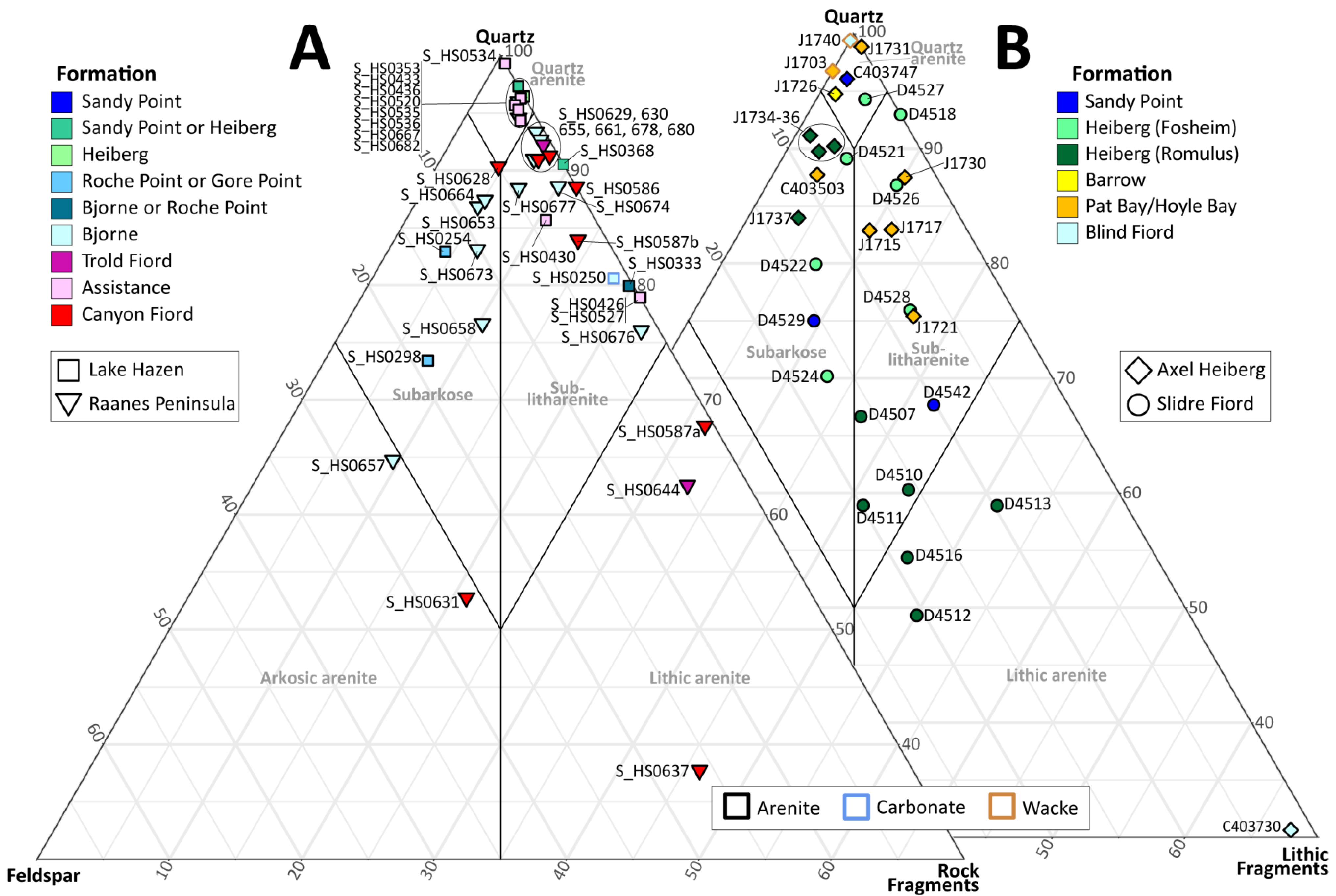
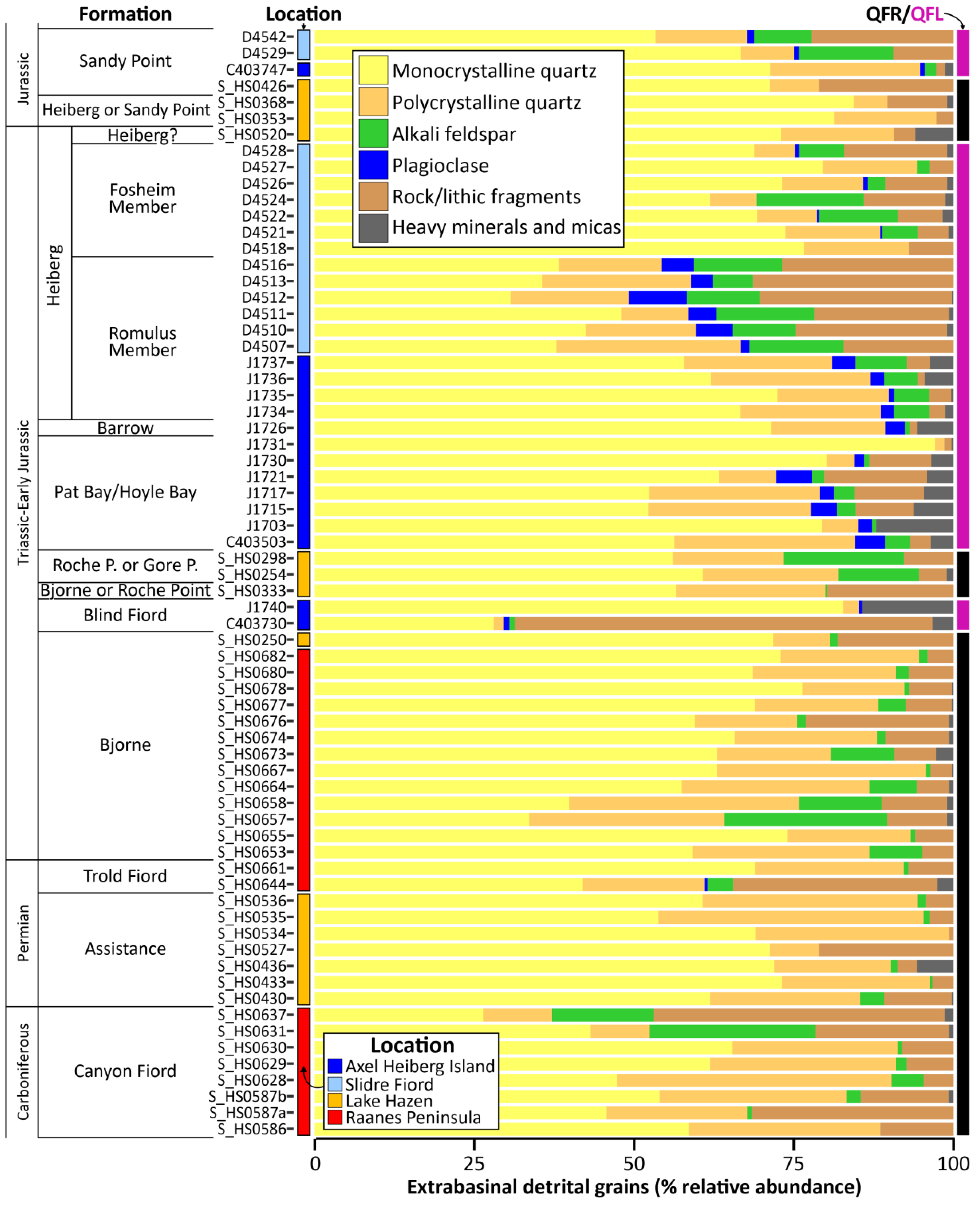



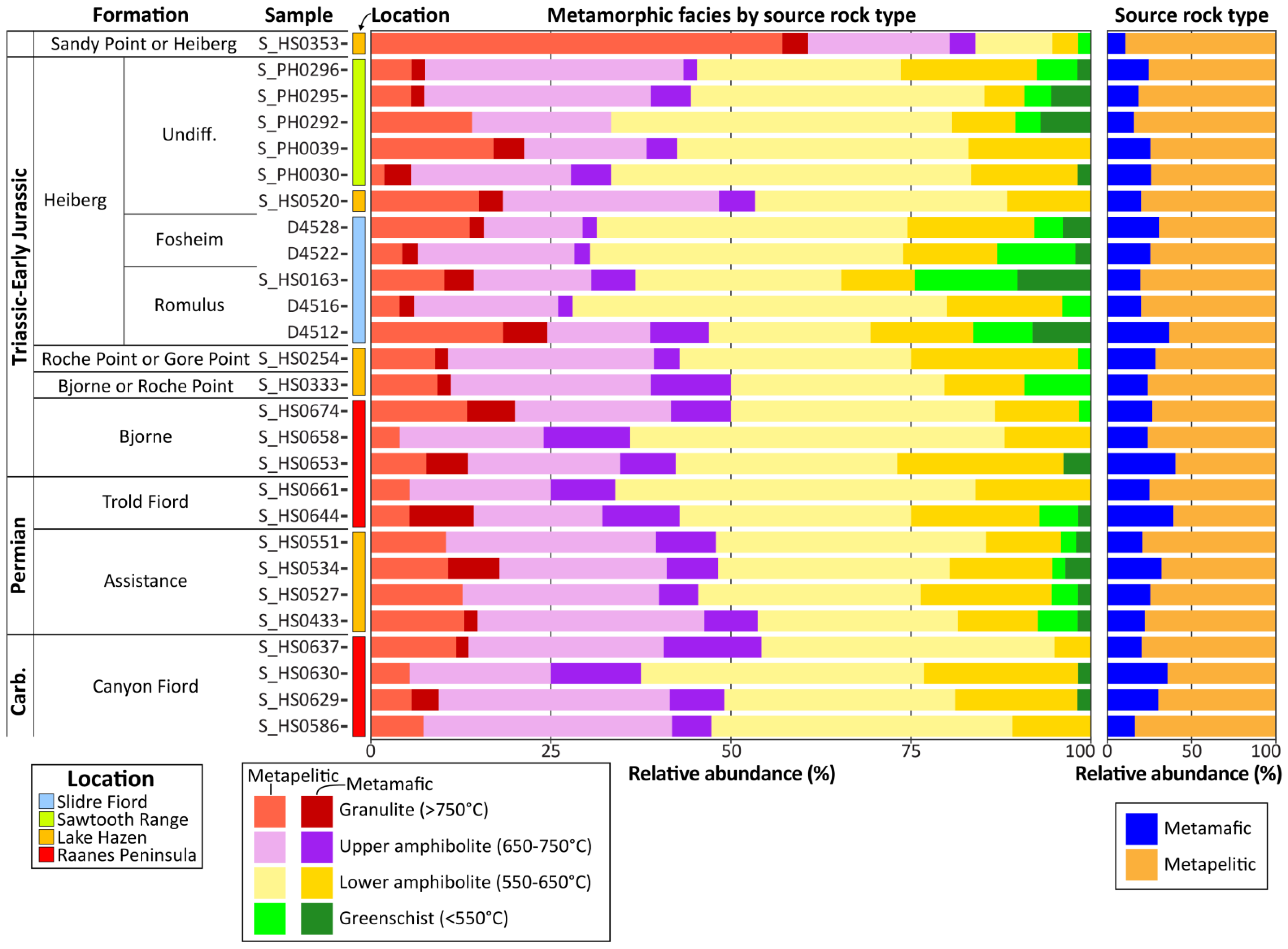


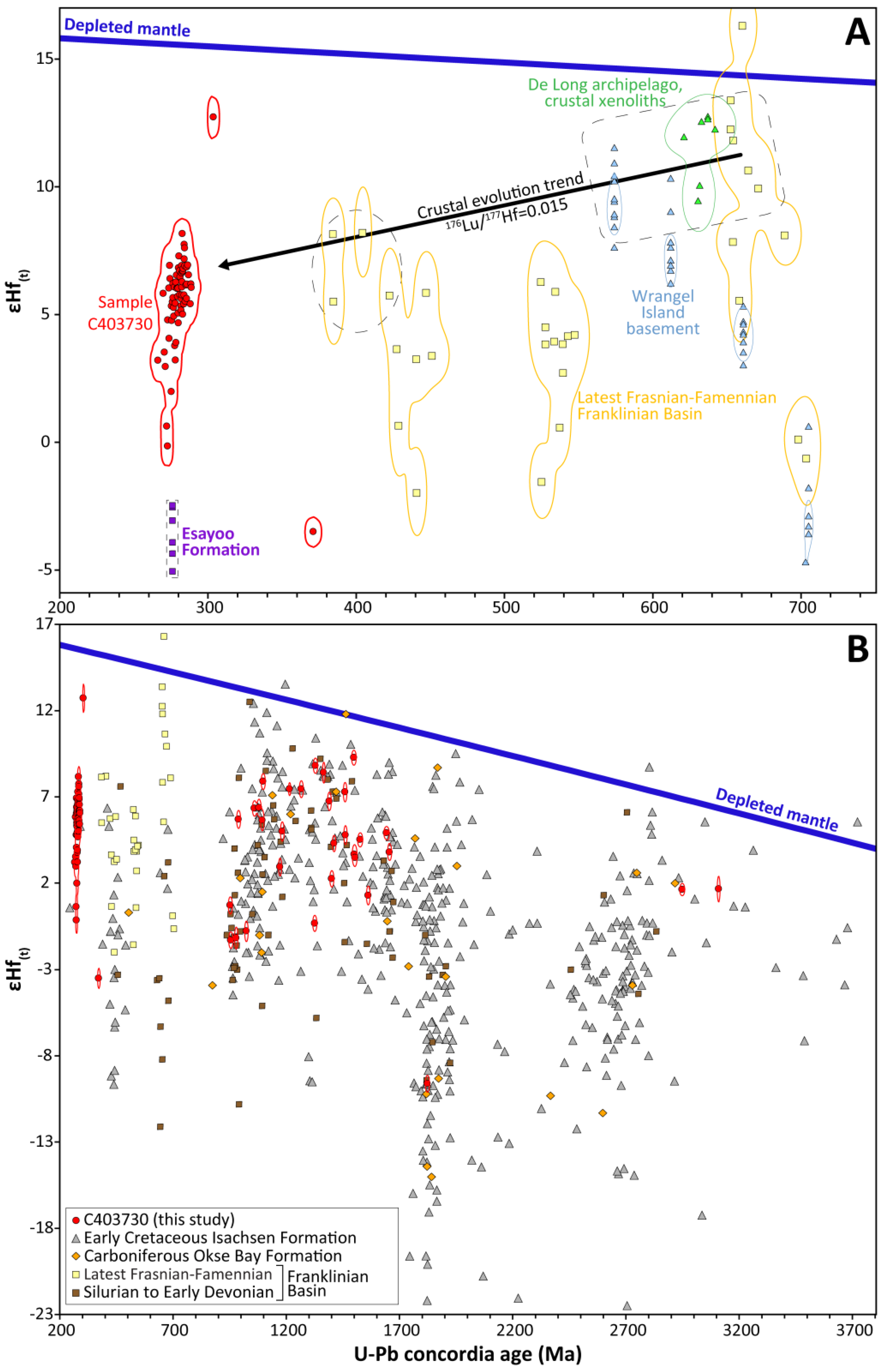
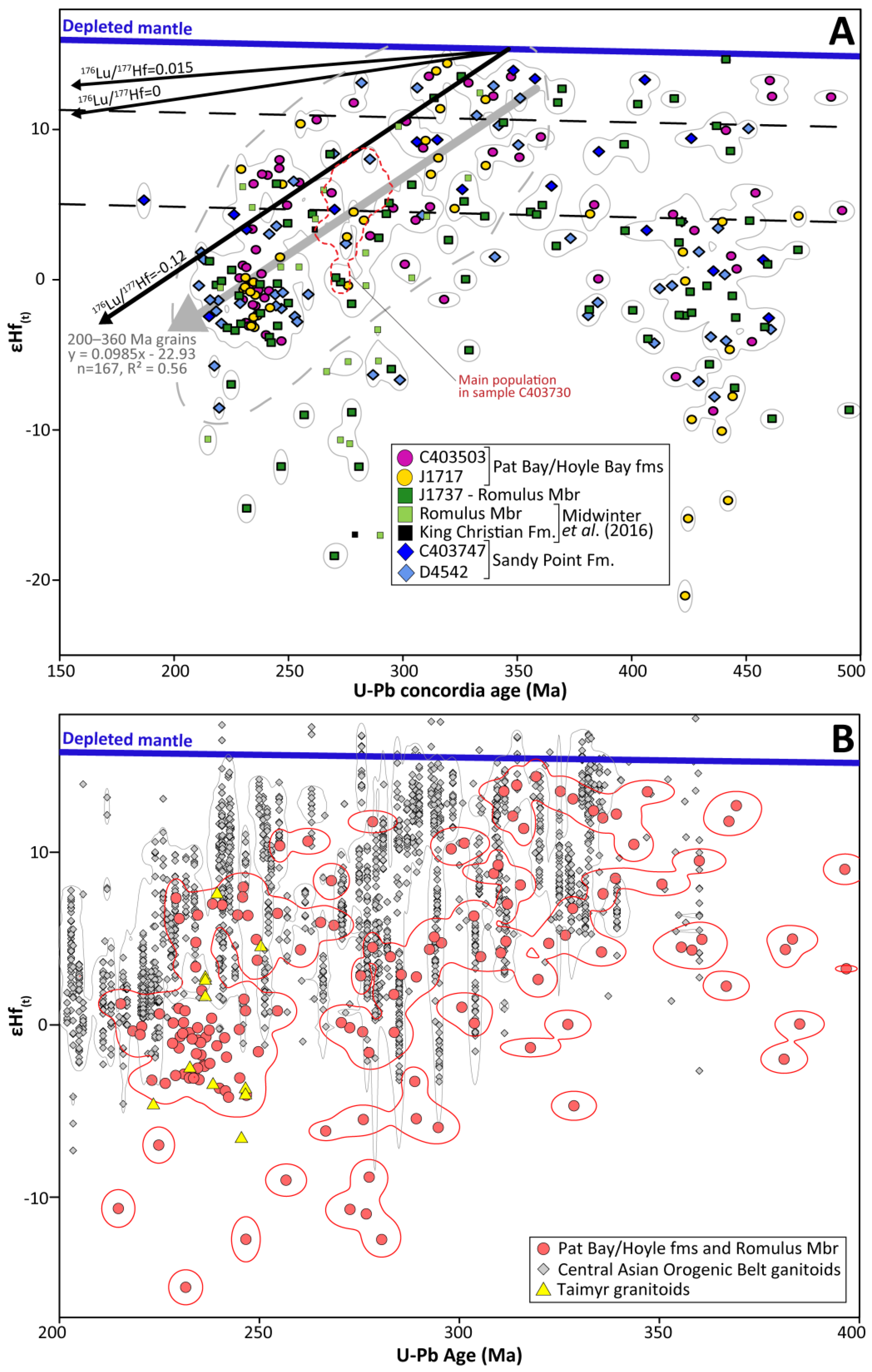
| Sample Number | Region | Formation | Member | Petrography | Heavy Mineral Analysis | Geochemistry | Zircon U–Pb | Zircon Lu–Hf | ||
|---|---|---|---|---|---|---|---|---|---|---|
| Apatite | Garnet | Rutile | ||||||||
| D4542 | Slidre Fiord | Sandy Point | Y | Y | Y | Y | ||||
| D4529 | Slidre Fiord | Sandy Point | Y | |||||||
| C403747 | N. Axel Heiberg Island | Sandy Point | Y | * | * | Y | ||||
| S_HS0426 | Lake Hazen | Sandy Point | Y | |||||||
| S_HS0368 | Lake Hazen | Sandy Point or Heiberg | Y | Y | ||||||
| S_HS0353 | Lake Hazen | Sandy Point or Heiberg | Y | Y | Y | Y | ||||
| S_HS0520 | Lake Hazen | Heiberg(?) | Y | Y | Y | |||||
| S_HS0292 | Lake Hazen | Heiberg(?) | Y | |||||||
| S_PH0296 | Sawtooth Range | Heiberg | Y | Y | ||||||
| S_PH0295 | Sawtooth Range | Heiberg | Y | Y | ||||||
| S_PH0292 | Sawtooth Range | Heiberg | Y | Y | Y | |||||
| S_PH0039 | Sawtooth Range | Heiberg | Y | Y | ||||||
| S_PH0035 | Sawtooth Range | Heiberg | Y | |||||||
| S_PH0032 | Sawtooth Range | Heiberg | Y | |||||||
| S_PH0031 | Sawtooth Range | Heiberg | Y | |||||||
| S_PH0030 | Sawtooth Range | Heiberg | Y | Y | Y | |||||
| S_PH0024 | Sawtooth Range | Heiberg | Y | |||||||
| S_HS0115 | Slidre Fiord | Heiberg | Fosheim | Y | ||||||
| D4528 | Slidre Fiord | Heiberg | Fosheim | Y | Y | Y | Y | |||
| D4527 | Slidre Fiord | Heiberg | Fosheim | Y | Y | |||||
| D4526 | Slidre Fiord | Heiberg | Fosheim | Y | ||||||
| D4524 | Slidre Fiord | Heiberg | Fosheim | Y | Y | |||||
| D4522 | Slidre Fiord | Heiberg | Fosheim | Y | Y | Y | ||||
| D4521 | Slidre Fiord | Heiberg | Fosheim | Y | Y | Y | ||||
| D4518 | Slidre Fiord | Heiberg | Fosheim | Y | Y | |||||
| S_HS0163 | Slidre Fiord | Heiberg | Romulus | Y | Y | Y | ||||
| S_HS0113 | Slidre Fiord | Heiberg | Romulus | Y | ||||||
| D4516 | Slidre Fiord | Heiberg | Romulus | Y | Y | Y | Y | |||
| D4513 | Slidre Fiord | Heiberg | Romulus | Y | Y | |||||
| D4512 | Slidre Fiord | Heiberg | Romulus | Y | Y | Y | Y | Y | Y | |
| D4511 | Slidre Fiord | Heiberg | Romulus | Y | Y | |||||
| D4510 | Slidre Fiord | Heiberg | Romulus | Y | ||||||
| D4508 | Slidre Fiord | Heiberg | Romulus | Y | Y | |||||
| D4507 | Slidre Fiord | Heiberg | Romulus | Y | ||||||
| J1737 | N. Axel Heiberg Island | Heiberg | Romulus | Y | Y | Y | Y | |||
| J1736 | N. Axel Heiberg Island | Heiberg | Romulus | Y | Y | |||||
| J1735 | N. Axel Heiberg Island | Heiberg | Romulus | Y | ||||||
| J1734 | N. Axel Heiberg Island | Heiberg | Romulus | Y | ||||||
| S_PH0011 | Sawtooth Range | (Schei Point Group, undifferentiated) | Y | |||||||
| S_HS0107 | Slidre Fiord | Barrow | Y | Y | ||||||
| D4548 | Slidre Fiord | Barrow | Y | |||||||
| J1726 | N. Axel Heiberg Island | Barrow | Y | Y | ||||||
| J1731 | N. Axel Heiberg Island | Pat Bay/Hoyle Bay | Y | |||||||
| J1730 | N. Axel Heiberg Island | Pat Bay/Hoyle Bay | Y | |||||||
| J1721 | N. Axel Heiberg Island | Pat Bay/Hoyle Bay | Y | Y | ||||||
| J1717 | N. Axel Heiberg Island | Pat Bay/Hoyle Bay | Y | Y | Y | Y | ||||
| J1715 | N. Axel Heiberg Island | Pat Bay/Hoyle Bay | Y | Y | ||||||
| J1703 | N. Axel Heiberg Island | Pat Bay/Hoyle Bay | Y | Y | ||||||
| C403503 | N. Axel Heiberg Island | Pat Bay/Hoyle Bay | Y | * | * | Y | ||||
| S_HS0298 | Lake Hazen | Roche Point or Gore Point | Y | Y | Y | |||||
| S_HS0254 | Lake Hazen | Roche Point or Gore Point | Y | Y | Y | Y | Y | |||
| S_HS0333 | Lake Hazen | Bjorne or Roche Point | Y | Y | Y | Y | ||||
| J1740 | N. Axel Heiberg Island | Blind Fiord | Y | |||||||
| C403730 | N. Axel Heiberg Island | Blind Fiord | Y | * | */Y | Y | ||||
| S_HS0250 | Lake Hazen | Bjorne(?) | Y | |||||||
| S_HS0683 | Raanes Peninsula | Bjorne | Y | |||||||
| S_HS0682 | Raanes Peninsula | Bjorne | Y | Y | ||||||
| S_HS0680 | Raanes Peninsula | Bjorne | Y | Y | ||||||
| S_HS0679 | Raanes Peninsula | Bjorne | Y | |||||||
| S_HS0678 | Raanes Peninsula | Bjorne | Y | Y | ||||||
| S_HS0677 | Raanes Peninsula | Bjorne | Y | |||||||
| S_HS0676 | Raanes Peninsula | Bjorne | Y | Y | ||||||
| S_HS0674 | Raanes Peninsula | Bjorne | Y | Y | Y | Y | Y | |||
| S_HS0673 | Raanes Peninsula | Bjorne | Y | Y | Y | Y | ||||
| S_HS0667 | Raanes Peninsula | Bjorne | Y | Y | ||||||
| S_HS0664 | Raanes Peninsula | Bjorne | Y | Y | ||||||
| S_HS0658 | Raanes Peninsula | Bjorne | Y | Y | Y | Y | Y | |||
| S_HS0657 | Raanes Peninsula | Bjorne | Y | Y | Y | |||||
| S_HS0655 | Raanes Peninsula | Bjorne | Y | Y | ||||||
| S_HS0653 | Raanes Peninsula | Bjorne | Y | Y | Y | Y | Y | |||
| S_SR0099 | Raanes Peninsula | Trold Fiord | Y | |||||||
| S_HS0661 | Raanes Peninsula | Trold Fiord | Y | Y | Y | Y | ||||
| S_HS0644 | Raanes Peninsula | Trold Fiord | Y | Y | Y | |||||
| S_HS0551 | Lake Hazen | Assistance | Y | Y | Y | |||||
| S_HS0536 | Lake Hazen | Assistance | Y | Y | ||||||
| S_HS0535 | Lake Hazen | Assistance | Y | |||||||
| S_HS0534 | Lake Hazen | Assistance | Y | Y | Y | |||||
| S_HS0527 | Lake Hazen | Assistance | Y | Y | Y | Y | ||||
| S_HS0436 | Lake Hazen | Assistance | Y | |||||||
| S_HS0433 | Lake Hazen | Assistance | Y | Y | Y | |||||
| S_HS0430 | Lake Hazen | Assistance | Y | |||||||
| S_HS0640 | Raanes Peninsula | Canyon Fiord | Y | |||||||
| S_HS0637 | Raanes Peninsula | Canyon Fiord | Y | Y | Y | Y | Y | |||
| S_HS0631 | Raanes Peninsula | Canyon Fiord | Y | Y | Y | |||||
| S_HS0630 | Raanes Peninsula | Canyon Fiord | Y | Y | Y | Y | ||||
| S_HS0629 | Raanes Peninsula | Canyon Fiord | Y | Y | Y | Y | ||||
| S_HS0628 | Raanes Peninsula | Canyon Fiord | Y | Y | ||||||
| S_HS0587b | Raanes Peninsula | Canyon Fiord | Y | |||||||
| S_HS0587a | Raanes Peninsula | Canyon Fiord | Y | |||||||
| S_HS0586 | Raanes Peninsula | Canyon Fiord | Y | Y | Y | Y | ||||
Disclaimer/Publisher’s Note: The statements, opinions and data contained in all publications are solely those of the individual author(s) and contributor(s) and not of MDPI and/or the editor(s). MDPI and/or the editor(s) disclaim responsibility for any injury to people or property resulting from any ideas, methods, instructions or products referred to in the content. |
© 2022 by the authors. Licensee MDPI, Basel, Switzerland. This article is an open access article distributed under the terms and conditions of the Creative Commons Attribution (CC BY) license (https://creativecommons.org/licenses/by/4.0/).
Share and Cite
Pointon, M.A.; Smyth, H.; Omma, J.E.; Morton, A.C.; Schneider, S.; Hülse, P.; Rippington, S.J.; Lopez-Mir, B.; Crowley, Q.G.; Millar, I.; et al. A Multi-proxy Provenance Study of Late Carboniferous to Middle Jurassic Sandstones in the Eastern Sverdrup Basin and Its Bearing on Arctic Palaeogeographic Reconstructions. Geosciences 2023, 13, 10. https://doi.org/10.3390/geosciences13010010
Pointon MA, Smyth H, Omma JE, Morton AC, Schneider S, Hülse P, Rippington SJ, Lopez-Mir B, Crowley QG, Millar I, et al. A Multi-proxy Provenance Study of Late Carboniferous to Middle Jurassic Sandstones in the Eastern Sverdrup Basin and Its Bearing on Arctic Palaeogeographic Reconstructions. Geosciences. 2023; 13(1):10. https://doi.org/10.3390/geosciences13010010
Chicago/Turabian StylePointon, Michael A., Helen Smyth, Jenny E. Omma, Andrew C. Morton, Simon Schneider, Peter Hülse, Stephen J. Rippington, Berta Lopez-Mir, Quentin G. Crowley, Ian Millar, and et al. 2023. "A Multi-proxy Provenance Study of Late Carboniferous to Middle Jurassic Sandstones in the Eastern Sverdrup Basin and Its Bearing on Arctic Palaeogeographic Reconstructions" Geosciences 13, no. 1: 10. https://doi.org/10.3390/geosciences13010010
APA StylePointon, M. A., Smyth, H., Omma, J. E., Morton, A. C., Schneider, S., Hülse, P., Rippington, S. J., Lopez-Mir, B., Crowley, Q. G., Millar, I., Whitehouse, M. J., Frei, D., Scott, R. A., & Flowerdew, M. J. (2023). A Multi-proxy Provenance Study of Late Carboniferous to Middle Jurassic Sandstones in the Eastern Sverdrup Basin and Its Bearing on Arctic Palaeogeographic Reconstructions. Geosciences, 13(1), 10. https://doi.org/10.3390/geosciences13010010









